Benny Lewis's Blog, page 8
January 5, 2024
How to Remember Words in Another Language: Strategies for Long-Term Language Skill Retention
Everyone at some time in their life struggles to understand how to remember words they’ve learned for the first time. Learning a language is valuable whether you’re doing it for fun or your career. You may have learned the basics of another language in grade school or college, but how much do you remember? If you need or want to learn a new dialect, you must set up a long-term plan to retain this knowledge in your head. How can you achieve fluency? How does learning a different tongue benefit you? Here’s how to learn for the long haul.
function runSplitTest(){var randomNumber = Math.floor(Math.random() * 2) + 1console.log(randomNumber)var copy = "";if (randomNumber == 3){ copy = '<i>A note from the Fluent in 3 Months team before we get started: You can chat away in a new language for at least 15 minutes with the "Fluent in 3 Months" method. All it takes is 90 days. <a href="https://www.fluentin3months.com/other... this link to find out more.</a></i>'} else { copy = '<i>A note from the Fluent in 3 Months team before we get started: You can chat away with a native speaker for at least 15 minutes with the "Fluent in 3 Months" method. All it takes is 90 days. <a href="https://www.fluentin3months.com/other... this link to find out more.</a></i>'}var copyToChange = document.querySelector("p.copyText").innerHTML = copy;}runSplitTest();Strategies for Long-Term Language Skill RetentionIf you dream of learning Spanish, Urdu or Russian, prepare for a lifelong journey. You can quickly learn a new language with time and effort, but it takes practice and variations of training to retain your studying. Here are eight strategies for long-term language skill retention.
Establish a Practice RoutineFirst, you need to establish a routine. Language learning and language retention both require practice, so carve out weekly time to focus solely on your journey. While busy schedules can understandably be a limiting factor, find time to study for 10 minutes daily.
Understanding of how to remember words can vary drastically from person to person. Some forget languages entirely if they don’t use them, while others retain knowledge just fine. A 2022 University of York study finds people who last took a French exam 50 years ago demonstrated the same proficiency as recent students. Still, you can significantly help your language retention by practicing daily and broadening your horizons. Allocate time during the week and more during the weekend for serious studying.
Diversify Your LearningDeveloping a routine is an excellent first step in your language learning. The next challenge is to diversify your study methods. Some choose the memorization route by practicing vocabulary and their pronunciations. While any practice is admirable, implementing a holistic approach is essential to ensure high comprehension. Learn in different ways to ensure your brain truly understands the language.
A 2021 Universitas Negeri Makassar study examines students’ learning strategies to learn English. The researchers found the top four methods are listening, speaking, reading and writing. Each process stimulates your brain differently and prepares you for real-world situations. For example, you may encounter a native speaker or a website using your intended language. Practicing for these scenarios ensures your comprehension.
Immerse Yourself in the LanguageWhile vocabulary and writing drills are terrific, there’s nothing like immersing yourself in another language to understand a different culture’s nuances. The native speakers may be far from you, but there are multiple opportunities to connect with a dialect and become one with it.
An excellent way to start is by reading children’s books and easy-to-read novels online, whether translated from English or the original language. Reading books you’re already familiar with is a solid launching pad because you know what to expect. For example, try reading “The Very Hungry Caterpillar” in another language. German speakers call it “Die kleine Raupe Nimmersatt,” whereas French speakers say “La Chenille Qui Fait Des Trous.”
Books let you read at your own pace but can be tricky when learning pronunciations. Try watching TV shows and films to immerse yourself in the language. While dubs of American shows are helpful, watch original programs like sitcoms, game shows or soap operas. Spanish learners may watch “Si Nos Dejan,” the most popular telenovela in Mexico in 2022.
Regardless of your choice, it’s essential to incorporate cognitive strategies when learning. These methods challenge your brain by making you analyze and apply your knowledge instead of simply memorizing. A 2021 International Journal of Academic Research in Business and Social Sciences study finds cognitive strategies are the most popular method for English learners because of their practicality in language learning.
Stay Current With Native MediaAnother way to help your language learning is to stay current with media in your intended dialect. For example, those learning English may rely on the British Broadcasting Corp. (BBC) to read news in the United Kingdom’s language. If you’re learning Japanese, read The Japan Times and watch news broadcasts. This practice will help you understand the language and see the news from others’ perspectives.
The internet and social media let you see the world by tapping your screen. Use YouTube, TikTok and other video services to consume media in your desired language. These videos give you a glimpse into what’s trending in different cultures and how they perceive well-known people and events.
For example, if you like Kevin James’ TV shows and movies, read what German media says about them. The comedian’s sitcom “King of Queens” was a popular show in Germany, and James’ movies typically bring solid viewership each time.
Learn With OthersLearning a retaining language is the most sustainable when you are passionate about it and have goals for your progress. With that in mind, consider roping in a friend to learn with you. Companions in this journey add motivation because you have someone to share your experience with. Plus, you’ll create a unique bond because you can use another language with each other, and people around you probably won’t understand you.
Involving a friend is also excellent because you always have someone to practice with. You can incorporate a new language by yourself, but it’s more fun when you have someone nearby who will test and refresh your skills. Practicing with a pal also helps you prepare for conversations used in the real world with native speakers.
Use the Language at HomeIf you don’t have a language partner, there are still ways to boost your learning experience. Try using it at home by labeling items in your desired dialect. Connecting your furniture and appliances to another language assists your journey because you’re learning everyday words applicable to your life.
Another way to bring the dialect home is to teach your children the basics. Starting your child’s journey early sets them up for success because they’ll have a basis for a second language when they start high school and college. Young children don’t have to know the ins and outs of the dialect, but using vocabulary for household items will help their understanding.
Sign up for a Class On How to Remember WordsIf you’ve considered going back to school, you’re not alone. A 2022 survey finds that 11% of American adults have contemplated returning to school to trailblaze a new career path. The same poll finds that 8% have already returned to school for extra learning. Signing up for a college class in your desired language may be just what you need for a long-term strategy.
College classes are excellent places to learn because your instructor will be a trained professional in the language. They’ll guide you in understanding your desired tongue and the resources necessary for succeeding. Plus, you’ll likely have classmates in a similar position as you — adults who seriously want to learn a language and make it stick for a long time.
Avoid BurnoutLearning a new language is a beautiful idea because it brings many benefits. However, there is such a thing as going overboard. Doing too much too quickly can result in burnout. Alternatively, you may feel stuck in your journey and need more motivation. These circumstances demonstrate burnout and can negatively impact your learning.
If you feel burnout, you have a few options. First, consider switching your learning strategy. Scale back if you feel overwhelmed by the material, or try a new method if you’re in a rut. Contemplate taking a break for a while if it’s too much. Start fresh when you feel like you can return with motivation.
Benefits of Long-Term Language RetentionLearning another language is excellent because it’ll be handy when needed. Science has even backed some health benefits of language learning. Here are some of the most important advantages.
Knocking Down Language BarriersFirst, consider the modern economic landscape. Globalization of industries has led to many companies branching out into other countries. Knowing a second or third language can elevate your career, especially if you’re fluent in an in-demand language. For example, over 1 billion people speak Mandarin, making it a popular language to learn in business. Ultimately, the dialect you should choose depends on your industry’s and company’s needs.
Knowing multiple languages can significantly help you in your organization and secure a lucrative position with another company. With globalization, it’s slowly becoming a must. A survey reveals 43% of HR professionals say their organization officially uses more than two languages. In today’s economy, you must be able to contact business partners in Japan, Egypt, Greece and other corners of the world.
Heightening Your Reading PerformanceLearning a new language helps you understand your native tongue, even if you don’t realize it. When you wield a new language, you sharpen your grammar skills with subject-verb agreement and sentence structure lessons. You learned your native language’s basics in grade school but might not have given much thought to its structure, considering your immersion. However, learning a new dialect sharpens the tools in your brain.
Learning a new language helps you understand better what goes into each sentence. Thus, you boost your reading performance and comprehension. A 2019 study examined Hong Kong students as they learned English. The researchers found learning a new language helped the students become more aware of metacognitive knowledge and increased their performance in reading exercises.
Unlocking CreativityCreativity is an essential soft skill because it proves you are flexible and can think quickly on your feet. How can you be more creative and inventive professionally and personally? Learning a new language assists in unlocking your artistry and making you more productive.
Training yourself in a new language typically means learning about a country’s history and culture. For example, learning Portuguese will help you understand customs in Portugal, Brazil, Cape Verde, Mozambique and other countries where people speak this language. Knowing multiple languages makes you a more well-rounded and creative person.
Language learning boosting creativity has its basis in science, too. A 2019 British Academy study demonstrates bilingualism positively enhances creativity by unlocking your brain’s potential. Knowing another dialect lets you switch quickly between dialects and makes you adapt to each discipline.
Improving Your HealthConquering a second language can improve mental health by making you feel proud and accomplished. Your confidence only heightens when you discover the beauty of a culture and improve your communication with the people. While there are mental health benefits, did you know there are also physical health advantages? Some people see better cognitive function and brain plasticity with language learning. Your brain is the primary recipient of this journey.
One way your brain benefits is an increase in myo-inositol (INS). A 2021 Scientific Reports study finds bilinguals have a higher INS concentration, which is even more critical as you age because it protects your brain from dementia and other diseases. Similarly, bilingualism predicts your n-acetylaspartate acid (NAA) concentration, with researchers saying it’s less prevalent in bilinguals than those who only know one language.
How to Remember Words and Make the Language StickKnowing a second, third or fourth language makes you feel powerful. You can speak with another person in their native tongue when many people you know can’t accomplish the same feat. While learning is impressive, you may struggle to make it stick in the long run. Use these eight strategies for long-term retention to learn how to remember words and reap the mental and physical benefits of language learning.
The post How to Remember Words in Another Language: Strategies for Long-Term Language Skill Retention appeared first on Fluent in 3 Months.
December 29, 2023
Talk About Japanese Animals: Essential Vocabulary about Animals in Japanese
It’s not enough to be able to talk about people in Japanese – we need to learn how to talk about animals, too! What animals are you likely going to find in Japan? What do animals sound like in Japanese – in other words, what are some animal-related onomatopoeia? And how are animals connected to Japanese culture? Keep reading to find out!
First of all, in Japanese, the word for “animal” or “animals” is 動物 (doubutsu).
You’ll run into all sorts of animals – in person or in conversation! In cities and towns, you’ll most commonly encounter animals at home as pets (or pests), in zoos, or in businesses. (You may have heard of cat cafes – but did you know there are cafes with hedgehogs, owls, and more?) If you’re in rural areas, you might come across all sorts of farm animals and wild animals. Here are some lists of animals you might find in all of these situations.
function runSplitTest(){var randomNumber = Math.floor(Math.random() * 2) + 1console.log(randomNumber)var copy = "";if (randomNumber == 3){ copy = '<i>A note from the Fluent in 3 Months team before we get started: You can chat away in Japanese for at least 15 minutes with the "Fluent in 3 Months" method. All it takes is 90 days. <b><a href="https://fluentin3months.com/challenge... this link to find out more.</b></a></i>'} else { copy = '<i>Editor's note: Before we get started, if you’re looking for an online Japanese course, here’s the course we recommend: <a href="https://www.fluentin3months.com/olly-... Uncovered - Learn Japanese Through the Power of Story</b></a>, a course with a fascinating new method by Olly Richards. You can try it for free for 7 days!</i>'}console.log(copy)var copyToChange = document.querySelector("p.copyText").innerHTML = copy;}runSplitTest();Table of contentsPets in JapaneseZoo Animals in JapaneseWild Animals in JapanAnimals in Japanese Mythology, Folklore, and SuperstitionsThe 12 Animals of the Japanese ZodiacAnimal Sounds in JapaneseNow You Know about Animals in JapanPets in JapaneseLearning about how to talk about pets is the best starting point for learning animals in Japanese. Who can resist talking about their furry (or feathery) best friend?
The word for “pet” in Japanese is ペット (petto). As you might have guessed, it comes from the English word!
While pets and animal companions have long been a part of Japanese culture, Japan has experienced a “pet boom” since the early 2000s. Especially as fewer people have children in Japan, more people are choosing to take care of animals for companionship. Many elderly people in Japan also enjoy keeping animals as pets.
Here are some animals you’ll commonly find as pets in Japan:
dog – 犬 (inu)cat – 猫 (neko)bird – 鳥 (tori)hamster – ハムスター (hamusutaa)mouse – なずみ (nezumi)rabbit – うさぎ (usagi)ferret – フェレット (feretto)hedgehog – ハリネズミ (harinezumi)fish – 魚 (sakana)koi fish (carp) – 鯉 (koi)rhinoceros beetle – カブトムシ (kabutomushi)snake – ヘビ (hebi)turtle – カメ (kame)Japanese living spaces are often quite small, especially in cities. Because of this, Japanese people often keep pets that can also live in compact spaces and are fairly easy to clean.
There are many varieties of native Japanese dogs. The most common are the shiba inu (柴犬, shibaken) and the Akita inu (秋田犬, akitaken). Thanks to the internet, they are now popular all over the world!
You may have also heard the story of Hachiko (ハチ公), the Akita dog who loyally waited for his owner at the station every day, even after he died. There is a famous statue of Hachiko outside of Shibuya Station and a wonderful statue of Hachiko reuniting with his owner at the University of Tokyo.

Hachiko being reunited with his owner, Dr. Ueno, at the University of Tokyo campus
Small dog breeds such as chihuahuas (チワワ, chiwawa), toy poodles (トイプードル, toi puudoru), and dachshunds (ダックスフンド, dakkusufundo) are also very popular.
However, not all pets are animals in Japan! Scientists and companies have been developing robotic pets, such as the robotic dog AIBO. Another notable robot pet is the baby harp seal PARO, which is being developed to provide emotional support for people in hospitals and nursing homes.
You may also have heard of cat cafes (猫カフェ, neko kafe) in Japan. At a cat cafe, you can pay a fee to enter and pet or play with the cats in the shop, and also have a small meal or a drink. Besides cat cafes, you might also find owl (フクロウ, fukurou) cafes, hedgehog (ハリネズミ, harinezumi) cafes, rabbit (うさぎ, usagi) cafes, dog (犬, inu) cafes, micro pig (マイクロブタ, maikuro buta) cafes, and more.
These are very popular because many apartments do not allow tenants to keep animals. Or people might not feel ready for the responsibility of caring for a pet.
However, keep in mind that animal rights are not as protected in Japan as they are in some other high-income countries. Therefore, some animal cafes operate more ethically than others. Some might have environments that are incredibly stressful for the animals, but others take very good care of them. Some cat cafes even take in abandoned cats and may let you adopt them! If these are issues close to your heart, it is a good idea to research the animal and cafe policies beforehand!
Speaking of which, animal shelters are called 動物保護施設 (doubutsu hogo shisetsu) in Japanese. They usually take care of stray dogs (野良犬, nora inu) and stray cats (野良猫, nora neko). They are slowly growing in popularity, but most Japanese people buy their animals from pet shops (ペットショップ, petto shoppu).
By the way, here are some common verbs to use with pets:
brush – ブラシする (burashi suru)I brush (my) dog. – 犬をブラシします (inu o burashi shimasu)pet – 撫でる (naderu)
Can I pet your dog? – 犬を撫でてもいいですか (inu wo nadetemo ii desu ka?)to take for a walk – 散歩に連れていく (sanpo ni tsurete iku) or 散歩させる (sanpo saseru)
I need to take my dog for a walk. – 犬を散歩に連れて行かなければなりません (inu wo sanpo ni tsurete ikanakereba narimasen.)Zoo Animals in Japaneseantelope – アンテロープ (anteroupu)camel – ラクダ (rakuda)capybara – カピバラ (kapibara)cheetah – チーター (chiitaa)elephant – ゾウ (zou)gazelle – ガゼル (gazeru)giraffe – キリン (kirin)gorilla – ゴリラ (gorira)hippo – カバ (kaba)hyena – ハイエナ (haiena)kangaroo – カンガルー (kangaruu)leopard – ヒョウ (hyou)lion – ライオン (raion)monkey – 猿 (saru)ostrich – ダチョウ (dachou)rhino – サイ (sai)sloth – ナマケモノ (namakemono)tiger – トラ (tora)zebra – シマウマ (shimauma)
If you go to an aquarium (or a sushi shop), you may also see many sea, lake, or river creatures:
alligator / crocodile – ワニ (wani)crab – カニ (kani)dolphin – イルカ (iruka)eel – 鰻 (unagi) (freshwater) / 穴子 (anago) (saltwater)jellyfish – クラゲ (kurage)lobster – ロブスター (robustaa)octopus – タコ (tako)otter – カワウソ (kawauso)penguin – ペンギン (pengin)seal – アザラシ (azarashi)seahorse – タツノオトシゴ (tatsunootoshigo)shark – サメ (same)shrimp – エビ (ebi)squid – イカ (ika)starfish – ヒトデ (hitode)stingray – エイ (ei)turtle – カメ (kame)walrus – セイウチ (seiuchi)whale – 鯨 (kujira)By the way, did you know that the famous Japanese monster Godzilla’s name comes from “gorilla” (gorira) and “whale” (kujira) mashed together?
Wild Animals in JapanWhether you’re in an urban or rural area, you will undoubtedly come across some wildlife. Here are some of the most common animals in Japan:
bear – 熊 (kuma)bee – 蜂 (hachi)boar – 猪 (inoshishi)butterfly – 蝶 (chou)centipede – ムカデ (mukade)cicada – 蝉 (semi)cockroach – ゴキブリ (gokiburi)crane – 鶴 (tsuru)crow – カラス (karasu)deer – 鹿 (shika)dragonfly – トンボ (tonbo)firefly – 蛍 (hotaru)frog – カエル (kaeru)fox – 狐 (kitsune)hornet – スズメバチ (suzumebachi)monkey – 猿 (saru)pigeon / dove – 鳩 (hato)raccoon dog – タヌキ (tanuki)viper – ハブ (habu)Of course, you likely won’t encounter all of these creatures! Bears, for example, are mostly found in the north, such as Hokkaido. The further south you get, the more you’ll need to deal with bigger and more dangerous bugs and insects, like hornets and giant centipedes.
However, some animals, like deer, you will find everywhere! Friendly deer are very famous for hanging around Nara and Miyajima.
There is also an island called Ookunoshima in Hiroshima that used to be so secret, it was removed from maps during World War Two because it manufactured poison gas. Now, it is overrun with spoiled, friendly bunnies! There are many stories explaining why, but no one knows for sure.
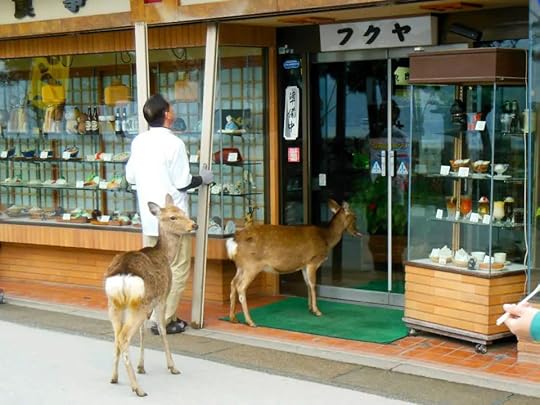
Deer trying to enter a store in the town next to Itsukushima Shrine on Miyajima
Unfortunately, cockroaches are pests everywhere. They also fly in Japan, making them very pesky! Luckily, you can buy convenient traps and sprays to use in your home. My favorite is called “Gokiburi Hoi Hoi,” known as a “Roach Motel” in English, which is a sticky trap that looks like a happy cockroach home. (Never mind that it’s not happy for them and is meant to kill them…) Just be careful if you have other pets or small children at home!
By the way, did you know that the national animal of Japan is the Japanese macaque, called 日本猿 (Nihonzaru) in Japanese? It literally means “Japan monkey,” and It’s actually the only wild species of monkey in Japan. So when Japanese people imagine a monkey, it’s usually this type!
The macaque was chosen as the national animal by Emperor Meiji at a time of widespread deforestation. Since the macaque was becoming endangered, he hoped that by choosing it as Japan’s national animal, he would help people understand the importance of conservation!
Animals in Japanese Mythology, Folklore, and SuperstitionsSo what traditional animals are sacred in Japanese culture? Actually, animals make many appearances in Japanese mythology, folklore, and spirituality!
In the indigenous Shinto religion, many deities are symbolized by animals. For example, Hachiman, the deity of war and Japan’s divine protector, is symbolized by a dove. Inari Ookami, the deity of rice and fertility, is symbolized by its messenger foxes. That’s why you see many fox statues at shrines that have inari gates! Other gods and goddesses are symbolized by dragons, or 龍 (ryuu).
Animals are also very present in mainstream superstitions and folklore. You may have heard trickster or shape shifting foxes, otters, and raccoon dogs. We have an entire article explaining more about these tales in length, so check it out!
In addition to these, Koi, believed to be incarnations of dragons, symbolize good fortune and longevity. Turtles and cranes also represent long-life.
Cranes actually have diverse symbolism. They also represent happy marriages, probably because they mate for life. Because of their connections with longevity, they furthermore represent good health, and now, peace. Some people believe that if you fold 1,000 paper cranes – called 千羽鶴 (senbadzuru) – your wish will come true. These are reasons why you often see strings of paper cranes at places representing peace, such as the Hiroshima war memorials. This was popularized by a girl named Sadako Sasaki, who became sick with leukemia after being exposed to radiation from the Hiroshima atomic bomb. She became famous for trying to fold 1,000 paper cranes before she died.

Loads of origami cranes donated to memorialize Fukuromachi School, which partially survived the atomic bombing, in Hiroshima City
Frogs represent many things, such as good fortune. Because the word for frog is the same as “to return,” 帰る(kaeru), they represent the idea that good things will come back to you, like good karma. You may see people going on a journey taking a frog charm with them! Since they can only leap forward, they also represent positive advancement or moving forward.
You may have seen a 招き猫 (maneki neko), or a white cat statue with a paw raised and beckoning you. These are common at the entrances of shops and restaurants. They represent good fortune and are believed to help bring the business more customers!
The Ainu, another indigenous group in Japan, also has rich mythology about animals. Bears are especially sacred in their culture, and they also have gods (called kamuy) related to owls, dragons, snakes, cranes, and more!
The 12 Animals of the Japanese ZodiacThe Japanese zodiac is very similar to the Chinese zodiac. In Japanese, the zodiac is called 干支 (eto). According to myth, the supreme god hosted a race for animals. The winners became the zodiac. In order of who finished from first to last, and listed with some of their positive and negative traits, we have:
rat – 子 (ne): energetic, resourceful, but greedy and rudeox – 丑 (ushi): hardworking and trustworthy, but narrow-mindedtiger – 寅 (tora): passionate and brave, but temperamental and impulsiverabbit – 卯 (u): elegant and tactful, but gullibledragon – 辰 (tatsu): noble and brave, but uncontrollable and temperamentalsnake – 巳 (mi): wise and persistent, but indifferent and too introvertedhorse – 午 (uma): determined and sociable, but impatient and inconsideratesheep – 未 (hitsuji): considerate and creative, but indecisive and meekmonkey – 申 (saru): versatile and resourceful, but manipulative and erraticrooster – 酉 (tori): independent and diligent, but aggressive and too ambitiousdog – 戌 (inu): loyal and practical, but stubborn and criticalboar – 亥 (i): honest and humble, but temperamental and naiveNote that many of the animals here have a different word and/or kanji for them than what is commonly used in modern Japanese.
Key differences from the Chinese zodiac are that the boar replaces the Chinese pig, and the sheep replaces the Chinese goat or ram. The year also changes with the solar calendar, following the Western year, rather than the lunar Calendar, like in Chinese culture.
Animal Sounds in JapaneseJapanese is rich in onomatopoeia, and animals make many different sounds! Here are some of the most common onomatopoeia to learn for animals:
Dogs say ワンワン (wan wan)Cats say ニャーニャー (nyaa nyaa)Birds say ピヨピヨ (piyo piyo)Mice say チューチュー (chuu chuu)Cows say モーモー (moo moo)Horses say ヒヒーン (hi hiin)Sheep say メー (mee)Pigs say ブーブー (buu buu)Roosters say コケコッコー (kokekokkoo)Ducks say ガーガー (gaa gaa)Owls say ホーホー (hoo hoo)Frogs say ケロケロ (kero kero)Monkeys say ウキウキ (uki uki)Foxes say コンコン (kon kon)Elephants say バオーン (baoon)Wolves say ワオーン (waoon)Dolphins say キューキュー (kyuu kyuu)Flies, bees, and other flying insects make ブーン (buun)Anything that roars, like a lion or a tiger, says ガオー (gaoo)Now you know why some anime girls will add in some nyaas to their sentences (to make them sound cute and cat-like) and how Pikachu (the electric mouse) got its name. And of course, how any Japanese person would respond to, “What does the fox say?”
Now You Know about Animals in JapanSo there you go! Now you can talk about what animals are common in Japan and what animals are sacred in Japan.
Once you have some of these words memorized, keep building your Japanese language skills with some sentence practice! You may now recognize many other animal references in Japanese pop culture, such as anime and video games, that involve very Japanese symbolism.
By learning about animals in Japan, you can enhance both your linguistic and cultural knowledge – what a win-win!
All About Korean Animals: 117 Animal Names in Korean You Need to Know12 Chinese Zodiac Signs: Discover and Talk About Your Birth Year in ChineseJapanese Zodiac Signs: How to Talk About Zodiac and HoroscopesAre Maths Geeks Better at Learning Languages?101+ German Animal Names (with English Translations)The post Talk About Japanese Animals: Essential Vocabulary about Animals in Japanese appeared first on Fluent in 3 Months.
December 22, 2023
Greek Numbers: How to Count from 1-1000+ in Greek
Looking to learn Greek numbers? Here’s some good news: once you’ve learned how to count from 1 to 20 in Greek, the rest is way easier since the other numbers all follow the same pattern.
And I know it gets easier, because I’m someone who’s learned to speak fluent Greek.
In this article, we’ll cover Greek numbers from 1 to 1000, in addition to some FAQs and historical information for those who love fun facts.
function runSplitTest(){var randomNumber = Math.floor(Math.random() * 2) + 1console.log(randomNumber)var copy = "";if (randomNumber == 3){ copy = '<i>A note from the Fluent in 3 Months team before we get started: You can chat away in a new language for at least 15 minutes with the "Fluent in 3 Months" method. All it takes is 90 days. <a href="https://www.fluentin3months.com/other... this link to find out more.</a></i>'} else { copy = '<i>A note from the Fluent in 3 Months team before we get started: You can chat away with a native speaker for at least 15 minutes with the "Fluent in 3 Months" method. All it takes is 90 days. <a href="https://www.fluentin3months.com/other... this link to find out more.</a></i>'}var copyToChange = document.querySelector("p.copyText").innerHTML = copy;}runSplitTest();Table of contentsGreek Numbers 1-10Greek Numbers 11-19Greek Numbers 20-100Greek Numbers After 100Greek Numbers in HistoryOrdinal Numbers in GreekUsing Greek Numbers in Real Life1. How to Tell Time in Greek2. How to Say “How Much Is It” in Greek3. How to Tell Your Phone Number in Greek4. How to Tell Your Age in GreekFAQs about Numbers in GreekHow do you count from 1 to 20 in Greek?Are Greek numbers the same as English?What are the Greek number prefixes?What is zero in Greek?Three, two, one, go!Greek Numbers 1-10Let’s start with the most important part: the first numbers you learn in any language, 1 to 10. It’s best to learn how to pronounce, read, and write these numbers very well before rushing to learn the numbers after 10.
Here is how you count from 1 to 10 in Greek:
1 – ένα (ena): “one”2 – δύο (dio): “two”3 – τρία (tria): “three”4 – τέσσερα (tessera): “four”5 – πέντε (pende): “five”6 – έξι (eksi): “six”7 – επτά (epta): “seven”8 – οκτώ (okto): “eight”9 – εννέα (enea): “nine”10 – δέκα (deka): “ten”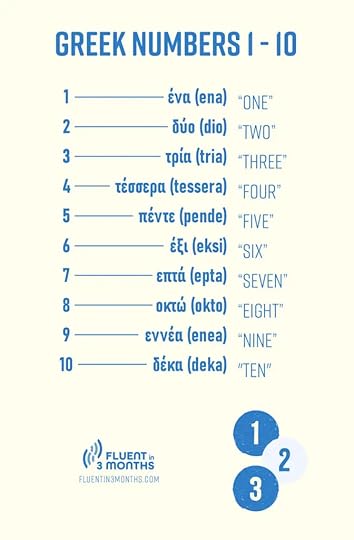 Greek Numbers 11-19
Greek Numbers 11-19Once you’re confident counting from 1 to 10, you will see that numbers between 10 and 20 are way more regular.
“Eleven” in Greek is έντεκα (endeka) and “twelve” is δώδεκα (dodeka). And you kind of already know the numbers from 13 to 19. How? Let me explain:
The numbers from 13 to 19 all start with δέκα (“ten”). Then, you add the other number depending on which number you want to tell. For example, fourteen is δεκατέσσερα; δέκα (“ten”) + τέσσερα (“four”) = δεκατέσσερα (dekatessera).
You can use the same logic until 19.
11 – έντεκα (endeka): “eleven”12 – δώδεκα (dodeka): “twelve”13 – δεκατρία (dekatria): “thirteen”14 – δεκατέσσερα (dekatessera): “fourteen”15 – δεκαπέντε (dekapende): “fifteen”16 – δεκαέξι (dekaeksi): “sixteen”17 – δεκαεπτά (dekaepta): “seventeen”18 – δεκαοκτώ (dekaokto): “eighteen”19 – δεκαεννέα (dekaenea): “nineteen”Greek Numbers 20-10020 in Greek is είκοσι (ikosi). 21 is 20+1, so είκοσι ένα. (ikosi ena). As you may have guessed, 22 is είκοσι δύο (ikosi dio), 23 is είκοσι τρία (ikosi tria), and so on. Keeping this logic in mind, we can figure out how to say bigger numbers as long as we know how to say 20, 30, 40, 50, 60, 70, 80, 90, and 100.
10 – δέκα (deka): “ten”20 – είκοσι (ikosi): “twenty”30 – τριάντα (trianda): “thirty”40 – σαράντα (saranda): “forty”50 – πενήντα (peninda): “fifty”60 – εξήντα (eksinda): “sixty”70 – εβδομήντα (evdominda): “seventy”80 – ογδόντα (ogdonda): “eighty”90 – ενενήντα (eneninda): “ninety”100 – εκατό (ekato): “one hundred”
Here are some examples of the numbers in between:
34 – τριάντα τέσσερα (trianda tessera): “thirty four”59 – πενήντα εννέα (peninda enea): “fifty nine”71 – εβδομήντα ένα (evdominda ena): “seventy one”83 – ογδόντα τρία (ogdonda tria): “eighty three”Greek Numbers After 100100 in Greek is εκατό and 101 is εκατόν ένα (ekaton ena). In numbers between 101 and 199, εκατό becomes εκατόν. After εκατόν, they again follow the same logic. For example, 118 is εκατόν δεκαοκτώ (ekaton dekaokto), which is the combination of εκατόν and δεκαοκτώ.
Some examples are:
105 – Εκατόν πέντε (ekaton pende): “one hundred and five”122 – Εκατόν είκοσι δύο (ekaton ikosi dio): “one hundred and twenty two”152 – Εκατόν πενήντα τέσσερα (ekaton peninda tessera): “one hundred and fifty four”172 – Εκατόν εβδομήντα δύο (ekaton evdominda dio): “one hundred and seventy two”199 – Εκατόν ενενήντα εννέα (ekaton eneninda enea): “one hundred and ninety nine”From 200 and onwards, you need to know how to say the hundreds. Pay attention to the endings — 200 is διακόσια, for example, notice that it’s written δια not δύο as in number two.
200 – διακόσια (diakosia): “two hundred”300 – τριακόσια (triakosia): “three hundred”400 – τετρακόσια (tetrakosia): “four hundred”500 – πεντακόσια (pentakosia): “five hundred”600 – εξακόσια (eksakosia): “six hundred”700 – επτακόσια (eptakosia): “seven hundred”800 – οχτακόσια (oktakosia): “eight hundred”900 – εννιακόσια (enniakosia): “nine hundred”1000 – χίλια (hilia): “one thousand”Greek Numbers in HistorySimilar to Babylonian, Egyptian, and Phoenician numeral systems, Ancient Greek numbers were also based on repeating single strokes up until number 9. So 9 would be expressed as “||| ||| |||.” For the number 10, different civilisations used different symbols. For example, in Crete, 10 used to be written as “―”.
Phoenicians influenced the first elaborate Greek number system. Today, it is known as Attic numerals, and it included using the first letter of each number as its symbol. So, for example, 5 was marked with the letter Π because pende starts with “pi,” Π / π. 10 was “Δ,” because deka starts with the letter “delta,” Δ / δ. Other Greek number symbols were:
100 = Η for ἑκατόν (hekaton)1000 = Χ for χίλιοι (hilioi)10000 = Μ for μύριοι (myrioi)Ordinal Numbers in GreekHow do you say “first”, “second”, and “third” in Greek? For that, you need ordinal numbers. Below, you can find the masculine versions, ending with ος (os). Depending on the gender, don’t forget to change the ending to η (i) for feminine and ο (o) for neutral nouns.
1st – πρώτος (protos): “first”2nd – δεύτερος (defteros): “second”3rd – τρίτος (tritos): “third”4th – τέταρτος (tetartos): “fourth”5th – πέμπτος (pemptos): “fifth”6th – έκτος (ektos): “sixth”7th – έβδομος (evdomos): “seventh”8th – όγδοος (ogdoos): “eighth”9th – ένατος (enatos): “ninth”10th – δέκατος (dekatos): “tenth”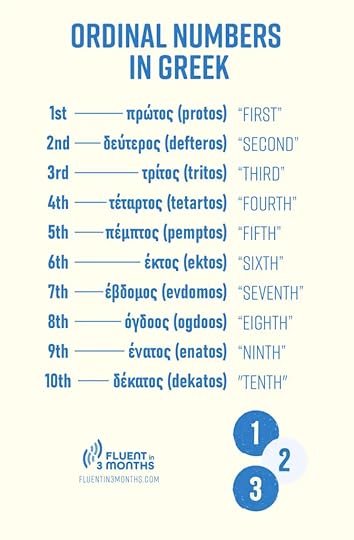 Using Greek Numbers in Real Life
Using Greek Numbers in Real LifeNow that we’ve learned the numbers in Greek, let’s take a look at four daily life situations where we would use numbers: telling what time it is, asking how much something costs, giving someone our phone number, and talking about our age.
1. How to Tell Time in GreekWhen someone asks you Τι ώρα είναι (ti ora ine?) “What time is it?” your answer will be a number. Here is how to say the hours in Greek — some of them have slightly different endings compared to the numbers from 1 to 10 we’ve just learned:
1 – μία (mia): “one”2 – δύο (dio): “two”3 – τρεις (tris): “three”4 – τέσσερις (teseris): “four”5 – πέντε (pende): “five”6 – έξι (eksi): “six”7 – επτά (epta): “seven”8 – οκτώ (okto): “eight”9 – εννέα (enea): “nine”10 – δέκα (deka): “ten”11 – έντεκα (endeka): “eleven”12 – δώδεκα (dodeka): “twelve”Τι ώρα είναι; (ti ora ine?): “What time is it?”Η ώρα είναι δύο (i ora ine dio): “It’s two o’clock.”Η ώρα είναι έντεκα (i ora ine endeka): “It’s eleven o’clock.”Here are some other examples for more vocabulary:
10:15: Δέκα και τέταρτο (deka ke tetarto): “Quarter past ten”07:45: Oκτώ παρά τέταρτο (okto para tetarto): “Quarter to eight”08:30: Oκτώ και μισή (okto ke misi): “Half past eight”2. How to Say “How Much Is It” in GreekTo say “how much does it cost” or “how much is it” in Greek, you can say Πόσο κοστίζει αυτό; (poso kostizi afto). Here are some possible answers to these questions.
Αυτή η τσάντα κοστίζει σαράντα ευρώ (Afti i tsanda kostizi saranta evro): “This bag costs forty euros.”Αυτό το μολύβι κοστίζει ένα ευρώ (Afto to molivi kostizi ena evro): “This pencil costs one euro.”Αυτό το φυλλάδιο είναι δωρεάν. (Afto to filadio ine dorean): “This brochure is for free.”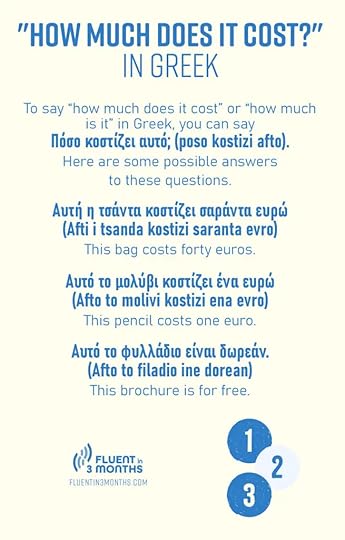 3. How to Tell Your Phone Number in Greek
3. How to Tell Your Phone Number in GreekYou can tell your phone number in Greek by pronouncing each digit one by one or two at a time.
Ποιος είναι ο αριθμός τηλεφώνου σου; (Pios ine o arithmos tilefonu su?): “What is your phone number?”Το τηλέφωνό μου είναι έξη, εννέα, πέντε, πέντε, τρία, επτά, οκτώ, ένα, πέντε, οκτώ. (To tilefono mu ine eksi, enea, pende, pende, tria, epta, okto, ena, pende, okto): “My phone number is 6-9-5-5-3-7-8-1-5-8.”Το τηλέφωνό μου είναι έξηντα εννέα, πενήντα πέντε, τριάντα επτά, ογδόντα ένα, πενήντα οκτώ (To tilefono mu ine eksinda enea, peninda pende, trianda epta, ogdonda ena, peninda okto): “My phone number is 69-55-37-81-58.”4. How to Tell Your Age in GreekAge is just a number. Well, this saying was probably not intended for language learners, but “How old are you” is one of the first questions we come across in a new language, and the answer is indeed a number.
Πόσο χρονών είσαι (poso hronon ise?): “How old are you?” (informal)Πόσο χρονών είστε (poso hronon iste?): “How old are you?” (formal or plural)Είμαι δεκαοκτώ χρονών (Ime dekaokto hronon): “I am 18 years old.”Είμαι είκοσι πέντε χρονών (Ime ikosi pende hronon): “I am 25 years old.”Είμαι τριάντα χρονών (Ime trianda hronon): “I am 30 years old.”FAQs about Numbers in GreekHow do you count from 1 to 20 in Greek?Here are the numbers from 1 to 20 in Greek:
1 – ένα (ena): “one”2 – δύο (dio): “two”3 – τρία (tria): “three”4 – τέσσερα (tessera): “four”5 – πέντε (pende): “five”6 – έξι (eksi): “six”7 – επτά (epta): “seven”8 – οκτώ (okto): “eight”9 – εννέα (enea): “nine”10 – δέκα (déka): “ten”11 – έντεκα (endeka): “eleven”12 – δώδεκα (dodeka): “twelve”13 – δεκατρία (dekatria): “thirteen”14 – δεκατέσσερα (dekatessera): “fourteen”15 – δεκαπέντε (dekapende): “fifteen”16 – δεκαέξι (dekaeksi): “sixteen”17 – δεκαεπτά (dekaepta): “seventeen”18 – δεκαοκτώ (dekaokto): “eighteen”19 – δεκαεννέα (dekaenea): “nineteen”20 – είκοσι (ikosi): “twenty”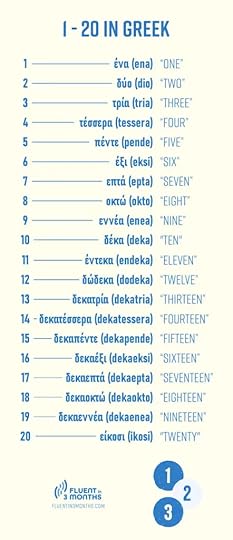 Are Greek numbers the same as English?
Are Greek numbers the same as English?Greek numbers are different from English numbers. That said, some of them, for example, τρία (tria) and “three,” do sound similar. This can make it easier to remember the numbers in Greek.
Greek numbers also have some similarities with Latin languages. If you know Spanish numbers, think about the number eight: it’s οκτώ (okto) in Greek and ocho in Spanish — they sound similar.
What are the Greek number prefixes?In other languages, such as English, some Greek words are used as prefixes to specify a number. “Mono” in “monopoly,” for example, comes from the Greek word μόνος (monos) that means “sole” or “only.” The Olympic sport “triathlon” consists of three sports: swimming, cycling, and running, and tri is the prefix that means “three.”
Here are the other number prefixes you might come across in science, math, or other words in daily life:
1: mono2: di3: tri4: tetra5: penta6: hexa7: hepta8: octa9: ennea10: decaWhat is zero in Greek?“Zero” in Greek is μηδέν (miden).
Three, two, one, go!Or should we say τρία, δύο, ένα go? Practice your Greek numbers by learning how to tell the time, going shopping and asking how much it costs, or using online resources!
The post Greek Numbers: How to Count from 1-1000+ in Greek appeared first on Fluent in 3 Months.
December 15, 2023
“Merry Christmas” in Japanese — How the Japanese Celebrate a “Merii Kurisumasu” and Other Winter Holidays
Do you hope to have a merry Christmas in Japan? Or do you have Japanese friends that you’d like to wish happy holidays to? In this article, I’ll teach you all about Japanese words, phrases, culture, and customs around the winter holidays, including Christmas and New Year’s. Now buckle up in your Santa sleigh–more than one thing about Christmas in Japan might surprise you in this article!
function runSplitTest(){var randomNumber = Math.floor(Math.random() * 2) + 1console.log(randomNumber)var copy = "";if (randomNumber == 3){ copy = '<i>A note from the Fluent in 3 Months team before we get started: You can chat away in Japanese for at least 15 minutes with the "Fluent in 3 Months" method. All it takes is 90 days. <b><a href="https://fluentin3months.com/challenge... this link to find out more.</b></a></i>'} else { copy = '<i>Editor's note: Before we get started, if you’re looking for an online Japanese course, here’s the course we recommend: <a href="https://www.fluentin3months.com/olly-... Uncovered - Learn Japanese Through the Power of Story</b></a>, a course with a fascinating new method by Olly Richards. You can try it for free for 7 days!</i>'}console.log(copy)var copyToChange = document.querySelector("p.copyText").innerHTML = copy;}runSplitTest();Table of contentsChristmas in JapanHow to Wish a “Merry Christmas” in JapaneseMerry Christmas in Japanese – Phrase ListHow to Celebrate Christmas with Food in JapanHow to Celebrate Christmas with a Date in JapanNew Year’s in JapanHappy New Year in JapaneseHappy New Year in Japanese – Phrase ListHow to Celebrate New Year’s in JapanMore Japanese Holiday GreetingsHave a Merry Christmas and a Happy New Year in Japanese! Christmas in Japan
Christmas in JapanFirst off, you may be wondering if Japan even celebrates Christmas. Japan’s name for Christmas is クリスマス (Kurisumasu), and it comes from the English word. This is because Christmas is not a traditionally celebrated holiday in Japan.
With an estimated less than one per cent of the population being Christian, you may assume that Christmas is not a popular holiday in Japan. But actually, it is a major holiday–although it differs greatly from how many other countries celebrate it.
Except for the small population of Christians, Christmas in Japan is a purely secular and mostly commercial holiday. It is celebrated on December 24, Christmas Eve. (This is クリスマスイブ Kurisumasu Ibu in Japanese.) It was only popularized as a major celebration in the 1970s. How, you may ask? The answer: an extremely successful KFC marketing campaign. More on that later!
How to Wish a “Merry Christmas” in JapaneseFirst, I’ll give you a few phrases to use.
The most popular way to say “Merry Christmas” in Japanese is simple. In Japanese characters, Merry Christmas is メリークリスマス (merii Kurisumasu)! This is the most common greeting. It can be used with anyone, regardless of whether they are at a higher or lower rank than you, or if they are Christian or not.
You may also already be familiar with the phrase おめでとうございます (omedetou gozaimasu). This phrase means “congratulations,” and it’s used in most other celebratory greetings, such as お誕生日おめでとうございます (otanjoubi omedetou gozaimasu) for “Happy birthday,” and 明けましておめでとうございます (akemashite omedetou gozaimasu) for “Happy New Year.” (We’ll go more in-depth about this last one later.)
So can we use use おめでとうございます (omedetou gozaimasu) to wish a merry or happy Christmas in Japanese? It is technically possible. This would make it クリスマスおめでとうございます (Kurisumasu omedetou gozaimasu). However, this is mostly used with people who are Christian and celebrating Christmas as a religious holiday. In other words, since most Japanese people don’t have a religious connection to it, they’re not particularly celebrating anything at Christmas. So this phrase is not very common.
By the way, at Japanese church services, you may also hear the greeting 主の御降誕おめでとうございます (Nushi no gokoutan omedetou gozaimasu). This is a much more stiff and formal phrase celebrating the “birth of our Lord.”
But as I said, you’re much more likely to hear the English-inspired Merii Kurisumasu in most cases.
Merry Christmas in Japanese – Phrase ListHere’s a recap of the different ways to say “Merry Christmas” in Japanese:
メリークリスマス (merii Kurisumasu) – “Merry Christmas”おめでとうございます (omedetou gozaimasu) – “Congratulations!”クリスマスおめでとうございます (Kurisumasu omedetou gozaimasu) – “Happy Christmas” (only to those celebrating Christmas as a religious holiday)主の御降誕おめでとうございます (Nushi no gokoutan omedetou gozaimasu) – “ Congratulations on the birth of our Lord”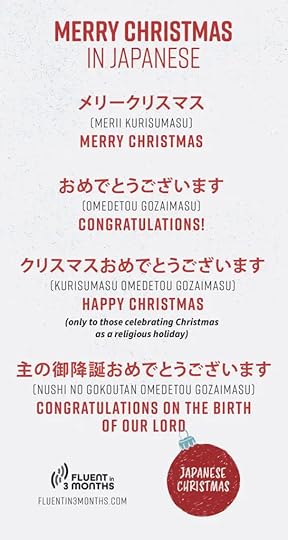 How to Celebrate Christmas with Food in Japan
How to Celebrate Christmas with Food in JapanSo as I mentioned, Christmas in Japan became popular from a KFC marketing campaign in the 1970s. Legend has it that a very devoted KFC manager overheard a foreigner expressing nostalgia for how they celebrated Christmas back home with turkey. Turkey is hard to find in Japan, but chicken is very common. So KFC went with the substitute and convinced the population that the right way to celebrate Christmas is by eating a bucket of KFC!
Even though the nationality of the foreigner overheard is unknown, KFC marketed eating fried chicken for Christmas as an American tradition, and this belief has stuck. (But as an American, I have my doubts that the foreigner in question would have been from the same country as me. Since turkey is a November Thanksgiving staple, many people are tired of turkey by the time Christmas rolls around. Who knows!) In any case, imagine the surprise when I tell Japanese people that we don’t eat KFC for Christmas!
Over the years, other fried chicken eateries joined the campaign. Nowadays, everywhere, including convenience stores, advertise their Christmas fried chicken deals toward the end of the year. But KFC reigns supreme. It is so popular that you may need to make your order and reserve your pick-up time slot several weeks in advance!
(Fun fact: Colonel Sanders is often dressed up in a Santa suit in Japan for marketing. With the white hair, I agree that they do look a bit similar!)

By the way, KFC is most commonly known as “Kentucky” in Japan. In Japanese, this is ケンタッキー (Kentakkii).
Another popular food eaten at this time in Japan is a “Christmas cake,” or クリスマスケーキ (kurisumasu keeki). This is usually quite similar to strawberry shortcake, and is a simple white sponge cake with strawberries and whipped cream on top. Ever notice the cake emoji ( ) on your phone? That’s the iconic Japanese Christmas cake!
) on your phone? That’s the iconic Japanese Christmas cake!
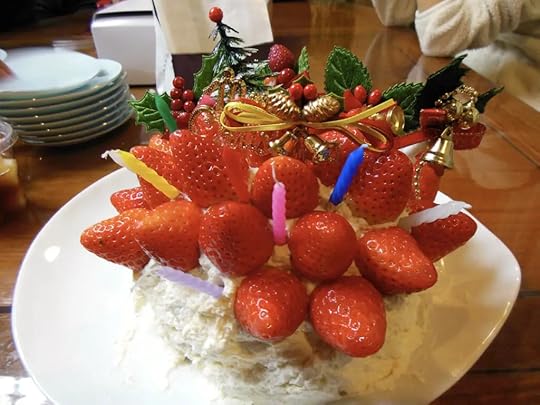
Christmas cakes might be especially popular around Christmas because of the white and red coloring. Although Japan generally values eating fruits and vegetables in-season, there’s a huge demand for strawberries in the winter because of Christmas cakes! That’s probably one of the reasons why many strawberries are grown in greenhouses in Japan.
Actually, many KFC Christmas deals include a Christmas cake with the bucket of chicken, and maybe even a bottle of champagne!
How to Celebrate Christmas with a Date in JapanNow, I alluded that Christmas is a romantic holiday in Japan. Actually, it’s like Valentine’s Day in many Western countries!
But wait, doesn’t Japan also celebrate Valentine’s Day? Yes, but it’s a bit different from Valentine’s Day in many Western countries. In Japan, women are expected to give chocolates and express their love to men. In return, men do the same for women on March 14, otherwise known as White Day.
So expectations are placed on one gender on Valentine’s Day and White Day, but for Christmas, they’re both on rather equal playing fields. This is why Japanese Christmas is similar to Valentine’s Day in the West. Couples go on a date デート (deeto) on Christmas Eve!

Around this time, there are many winter illuminations (冬のイルミネーション / fuyu no irumineeshon) around the country. Famous ones include Nabana no Sato (なばなの里) in Mie Prefecture, and Kobe Illuminarie (神戸イルミナリエ) in Hyogo Prefecture, and the Ashikaga Flower Park (あしかがフラワーパーク) in Tochigi Prefecture. These are incredibly popular date spots! Many couples also have a nice dinner in a fancy restaurant.
New Year’s in JapanYou might be wondering if Japan has a traditional holiday greeting. Yes, it does! Whereas Christmas is often the most important winter holiday in many other countries, New Year’s is the most important winter holiday in Japan.
Unlike Korea or China, Japan follows the New Year according to the solar calendar–not the Lunar New Year (also known as the Chinese New Year). It has done so since the late 19th century! That means they officially and culturally celebrate the new year at the same time as the majority of other countries, on the last day of December and the first day of January.
Happy New Year in JapaneseThe word for New Year’s Eve in Japanese is 大晦日 (Oomisoka). The word for New Year’s Day is お正月 (Oshougatsu). The word for New Year’s in general or just the “new year” is 新年 (shinnen).
And if you want to wish someone “Happy New Year,” you can say 明けましておめでとうございます (akemashite omedetou gozaimasu). Use this phrase to someone you show respect to, like an elder or your boss. If you are speaking casually, you drop the gozaimasu and just say 明けましておめでとう (akemashite omedetou). If you want to be really informal, you can contract it to アケオメ (akeome)!
The main verb in this phrase, 明ける (akeru) and conjugated as 明けまして (akemashite), is a homonym with the word “to open,” or 開ける (akeru). But don’t get them confused! Here with this specific kanji, it means “to dawn.” So you are congratulating someone on the dawning of a new year!
Also, usually, you say this phrase on New Year’s Day. But if you greet someone for the first time in the year and it’s relatively close to New Year’s Day, you can still say it!
If someone tells you this phrase, you can respond with the same, and then add 今年もよろしくお願いします (kotoshi mo yoroshiku onegaishimasu) if you are speaking formally. If casually, you can say 今年もよろしく (kotoshi mo yoroshiku). This doesn’t have a good direct translation into English, but it means something like, “I look forward to continuing our good relationship this year.”
Happy New Year in Japanese – Phrase ListHere’s a recap of the different ways to say “Happy New Year” in Japanese:
明けましておめでとうございます (akemashite omedetou gozaimasu) – “Happy New Year” (formal)明けましておめでとう (akemashite omedetou) – “Happy New Year” (informal)アケオメ (akeome)! – “Happy New Year” (casual)今年もよろしくお願いします (kotoshi mo yoroshiku onegaishimasu) – “I look forward to continuing our good relationship this year” (formal)今年もよろしく (kotoshi mo yoroshiku) – “I look forward to continuing our good relationship this year” (informal)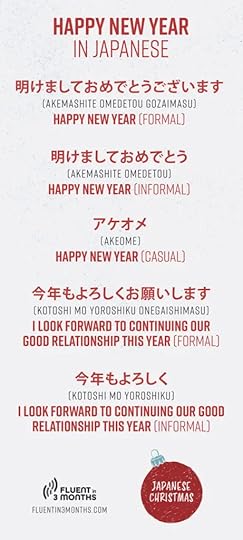 How to Celebrate New Year’s in Japan
How to Celebrate New Year’s in JapanWhile Christmas is a commercial holiday in Japan, New Year’s is a family-oriented holiday. It’s basically the reverse of the West, where Christmas is the family-oriented holiday, and New Year’s is a time to party!
Also, while Westerners might engage in “spring cleaning,” Japanese people do their major yearly cleaning (called 大掃除 / ososouji) around this time in preparation for the new year.
Of course, no Japanese celebration would be complete without special food. Many Japanese people eat 年越しそば (toshikoshi soba), which literally means “pass the year soba.” (Soba is a type of buckwheat noodle.) The long noodles represent a long life!

Other significant New Year’s foods お節料理 (o-sechi ryouri). This is a feast of several small dishes in an elaborate lacquered bento-like box, called a 重箱 (juubako). This tradition dates back to the Heian Period (794–1185), so it’s been around for a while! The main components of osechi ryouri often differ by region, so you might taste somewhat different ingredients if you travel to different parts of Japan over New Year’s!

Mochi, or pounded rice cakes, are commonly made and eaten around this time too. (Sometimes, they’ll be pounded by sumo wrestlers!) Although take care when you eat fresh mochi, since a few people (usually elderly) die every year choking on it. You may have also seen 鏡餅 (kagami mochi), which is two mochi topped with a tangerine leaf. This is purely decorational though–don’t try to eat it!
Finally, many families gather around the TV during the leadup to the New Year’s countdown. They watch Kohaku (紅白), a popular singing show where the nation’s most famous singers compete against each other. There are two teams: Team Red and Team White!
Otherwise, Japanese people might spend their New Year’s Eve at a Shinto shrine or Buddhist temple. At midnight, Buddhist temples ring their bells a total of 108 times. This occasion is called 除夜の鐘 (joya no kane) and symbolizes getting rid of the 108 earthly temptations according to Buddhism. The first shrine visit of the new year is also very important in Japanese culture. This is called 初詣 (hatumoude) or 初参り (hatsumairi).
More Japanese Holiday GreetingsMany Japanese workplaces shut down for New Year’s. So if you want to wish a colleague, “Have a happy New Year’s” before the break you can tell them 良いお年をお越しください (Yoi o-toshi wo okoshi kudasai). You might also hear other variants, such as 良いお年をお迎えください (Yoi o-toshi wo omukae kudasai). These are quite formal set phrases using keigo, or honorific language.
If you’d like to be a bit less formal, you can shorten this to 良いお年を (Yoi o-toshi wo)! This still uses some keigo, but it’s a bit less stiff. You can use this latter phrase quite flexibly. Whatever you’d like to wish someone to have a good one of, you can replace otoshi with that word. So, to say, “Have a good Christmas!” you can say, 良いクリスマスを (Yoi Kurisumasu wo).
To say, “Have a happy Hanukkah,” you can say, 良いハヌカー (Yoi Hanukaa wo)!
To say, “Have a good winter break,” you can say, 良い冬休みを (Yoi fuyuyasumi wo)!
You will usually say these phrases as a parting greeting. Usually it’s the last time you see that person until the holiday is over.
Greeting cards (グリーティングカード / guriitingu kaado) are also common to send around this time. In fact, mid-December and early January are the busiest times of the year for post offices in Japan! You may guess that Japanese people usually send New Year’s cards, rather than Christmas cards, though.
Greeting cards specifically for New Year’s are called 年賀状 (nengajou). They often include phrases such as ご健康とご多幸をお祈りいたします (go-kenkou to go-takou wo oinori itashimasu). This translates literally into something along the lines of “I am praying for your health and happiness.”
You may also see the phrases 謹賀新年 (kinga shinnen) or 賀正 (gashou) in greeting cards or on signs. These also mean “Happy New Year.” But they are written phrases, so you generally wouldn’t say them.
Other words you might see written in cards or on signs include 初春 (pronounced either shoshun or hatsuharu, meaning “early spring”) and 迎春 (geishun, “welcome spring”). These are a nod to the lunar calendar, which Japan used to follow.
Have a Merry Christmas and a Happy New Year in Japanese!The winter holiday season is a wonderful time to be in Japan and experience Japanese culture. Best yet, as you’ve learned, you can experience a mix of both modern and traditional celebrations in one short time frame!
So if you want to celebrate the winter holidays like a true Japanese person, grab your bucket of KFC and your Christmas cake, and go have a lovely date at a beautifully lit illumination. After that, join your loved ones for some mochi, some soba, and go visit some shrines and temples!
However you wish to celebrate, I hope you have a merii Kurisumasu, and akemashite omedetou gozaimasu!
Merry Christmas in Spanish: “Feliz Navidad” and More Spanish Holiday Vocab“Merry Christmas” in German – Vocab and Traditions of a “Frohe Weihnachten”!Christmas Traditions from Around the World“Merry Christmas” in Italian – How Italians Celebrate a “Buon Natale” [In-depth Guide]“Merry Christmas” in French – How to Have a “Joyeux Noël” [In-Depth Guide]The post “Merry Christmas” in Japanese — How the Japanese Celebrate a “Merii Kurisumasu” and Other Winter Holidays appeared first on Fluent in 3 Months.
December 8, 2023
40+ Cool Greek Words That Will Make You Want to Learn Greek
From alpha to omega, Greek letters come together to create some beautiful Greek words.
As the longest-documented Indo-European language, Greek has a rich history. Dating back to the 2nd millennium BC, the language has gone through many changes until it evolved into Modern Greek that is spoken today. All this history also means that it is not short of cool words.
For this article, we built a list of untranslatable, beautiful, and famous Greek words that you will find so cool that you will want to learn Greek. Some of these words will help you in everyday life as you speak Greek; some will broaden your vocabulary; and others will light the spark in your language journey. What do they have in common? They are all super cool!
function runSplitTest(){var randomNumber = Math.floor(Math.random() * 2) + 1console.log(randomNumber)var copy = "";if (randomNumber == 3){ copy = '<i>A note from the Fluent in 3 Months team before we get started: You can chat away in a new language for at least 15 minutes with the "Fluent in 3 Months" method. All it takes is 90 days. <a href="https://www.fluentin3months.com/other... this link to find out more.</a></i>'} else { copy = '<i>A note from the Fluent in 3 Months team before we get started: You can chat away with a native speaker for at least 15 minutes with the "Fluent in 3 Months" method. All it takes is 90 days. <a href="https://www.fluentin3months.com/other... this link to find out more.</a></i>'}var copyToChange = document.querySelector("p.copyText").innerHTML = copy;}runSplitTest();Table of contentsWhat are some untranslatable Greek words?What are some beautiful Greek words?What are some famous Greek words?What are some basic Greek words and phrases?Ready to learn Greek?What are some untranslatable Greek words?Many languages have untranslatable words, and Greek is definitely one of them. Let’s take a look as they show us a sneak peek into Greek culture.
Μεράκι (meraki)Meraki expresses a sense of soul and uniqueness. It’s the feeling when you’re doing something with such devotion that you’re putting in an essence of yourself. It could be any activity, for example, cooking, making jewellery, or playing a musical piece.Κελεπούρι (kelepuri)
Kelepuri is a “bargain.” When it’s used for objects, it conveys a good value for money. It can also be used for people, especially in a romantic way. In this case, it means “a catch” or “a keeper.”Φιλοξενία (filoksenia)
We can break the word filoksenia into two parts: the first part, filo, means “love,” and the second part ksenia means foreigner. So the literal meaning is the love of foreigners. The word, however, is used to express hospitality — think, the love of hosting guests.Φιλότιμο (filotimo)
Also rooting from the word filo, filotimo’s literal meaning is “love of honour.” When you say that someone has filotimo, it means that they honour their job and responsibilities in a dedicated way.Λεβέντης (levendis)
Levendis is used to describe a brave and handsome man. The word originates from Italian and dates back to the Middle Ages when there were pirates in the Eastern Mediterranean. Although it ended up taking a negative connotation in Italian, the word has a positive connotation in Greek.χαρμολύπη (harmolipi)
Combining the Greek words for joy and sadness, harmolipi conveys the coexistence of both. It can best be described in English as a feeling of bittersweetness.Καψούρα (kapsura)
Kapsura is a complex word. Some say that if you understand what it means, you’re already fluent in Greek! The word can be used for the infatuation someone experiences when they first fall in love, a strong desire, or a crush that probably won’t last long.Κέφι (kefi)
Similar to the Turkish word keyif or the Arabic word kayf, kefi can be described as a feeling of joy and being in a good mood. In Greek culture, gathering with family and friends, eating good food, and enjoying each others’ company are all moments of kefi.Όπα (opa)
Opa is commonly used in many Balkan, Mediterranean, Southern, and Eastern European countries. You can hear it during traditional dances or simply as an expression of surprise.Ρε (Re)
Probably the most untranslatable of them all, re is a slang word that has multiple uses. If you call a friend re, it has a similar meaning to “hey” or “dude” in English. You can also use it as an interjection to express surprise, anger, or astonishment when you want to grab someone’s attention.What are some beautiful Greek words?
As a language that has had an impact on so many areas, including science, philosophy, literature, mathematics, and art, Greek has so many beautiful words that they almost sound poetic.
Ποίημα (poima)I’ve already called Greek words poetic, so I might as well start with the word for “poem.” This word is of Ancient Greek origin and comes from the verb ποιέω, which means “to make” or “to create.”Ψυχή (psihi)
Psihi means “soul” in Greek. It is also the root word of psychology, which literally translates into “the study of the soul.”Αγάπη (agapi)
Referring to romantic love or unconditional love, agapi is one of the most beautiful words in Greek. Agapi mou, which translates into “my love” is a common way for Greek-speaking couples to call each other.Φίλος (filos)
Filos or fili in feminine and filo in neutral, mean friend. This word also resembles philia, which means a deep friendship, one of the four types of love for Ancient Greeks.Eλπίδα (elpida)
Some elements of Greek mythology are still present in Modern Greek. For example, the word elpida, meaning “hope”, comes from Elpis, who is the spirit of hope in Greek mythology.Θάλασσα (thalassa)
Have you heard the term thalassophile? This cool word describes a person who loves the sea or the ocean. Its origins are Greek, with thalassa meaning “sea.”Ήλιος (ilios)
Helios is the god of the Sun in ancient Greek religion. In Modern Greek, the word ilios means “sun” and it’s a masculine word since the Greek language has grammatical gender.Ελευθερία (elefteria)
Eleftheria i thanatos or “freedom or death” is the motto of Greece. The Greek word for “freedom,” elefteria is a feminine word and can also be a girl’s name.Αισθητική (estitiki)
No wonder why Greek architecture looks so aesthetic since the word aesthetic itself comes from Greek. It didn’t always have the meaning it had today though. In Ancient Greek, the word was related to the perception of things.Γειά μάς! (Yeia mas!)
An abbreviation of the phrase την υγεία μας (tin igeia mas), yia mas means “cheers” in Greek. Its literal translation is “to our health.” Next time you’re in Greece or Cyprus, raise your glass of ouzo over the delicious mezzes in a local taverna, and practice this word in its natural environment!What are some famous Greek words?
Did you know that more than 150,000 English words are derived from Greek? Even if you’re a beginner now, you will be surprised how many Greek words you already know.
Φοβία (phovia)In English, we use the suffix fobia to describe the fear of something. For example, claustrophobia is the fear of being in confined places. It comes from the Greek word fovos (“fear”).Mικρό (micro)
Literally meaning small in Greek, this word is used as a prefix in English for words such as microscope (helps us see small things) and microbe (very small living things).Διάλογος (dialogos)
In Ancient Greek, dia means “through” and logos means “speech.” The widely-used English version, “dialogue” is a conversation between two or more people.Τηλέφωνο (tilefono)
“Telephone” also derives from Ancient Greek, with “tele” meaning afar and “phone” meaning sound. If you are a language nerd like us, think about the word “phonetics” or the “International Phonetic Alphabet” to remember what the word fonos means!Μαραθώνιος (marathonios)
Marathon is a town in Greece where The Battle of Marathon happened between Persians and Greeks in 490 BC. During the war, the great long-distance runner Pheidippides the Greek was sent to Sparta to seek help. Later on, French linguist Michel Bréal coined the term “marathon” which means long-distance run. Since 1983, the Spartathlon Race takes place in Greece.Υγιεινή (igieni)
Igieni or “hygiene” is related to the Greek word υγεία (igea) which means “health” in English.Μουσική (musiki)
“Music,” a word that’s common in many world languages, is thought to be of Greek origin. In Greek mythology, the Muses are goddesses of literature, science, and the arts.Αρχιτέκτων (arhitekton)
Borrowed from Ancient Greek, “architect” has two Greek root words: archi (“chief”) and tekton (“builder”). So we can say that an architect in Greek translates into a master builder.Καρδιά (kardia)
Cardio exercises are the types of exercise that get your heart rate up. Have you ever wondered why they are called this way? Kardia means “heart” in Greek. This is the same root in “cardiology,” the branch of medicine that studies the heart.What are some basic Greek words and phrases?
Although they may seem less exciting than the untranslatable words or the words that come from Greek mythology, learning the basic words is the first step in learning Greek.
If the other words have inspired you already, let’s continue with some more words!
Γειά σου (yeia sou): “Hello” or “goodbye” (informal)Γειά σας (yeia sas): “Hello” or “goodbye” (formal or plural)Καλημέρα (kalimera): “Good morning”Καλησπέρα (kalispera): “Good afternoon / good evening”Καληνύχτα (kalinihta): “Good night”Ευχαριστώ (efharisto): “Thank you”Παρακαλώ (parakalo): “Please / you’re welcome”Ναί (neh): “Yes”Oχι (ohi): “No”Συγνώμη (sinyomi): “Excuse me”πως σε λένε; (pos se lene): “What is your name?”Με λένε (me lene): “My name is…”Χαίρω Πολύ (hero poli): “Nice to meet you”Εντάξει (endaxi): “Okay”Τι κάνεις; (ti kanis): “How are you?” (informal)Τι κάνετε; (ti kanete): “How are you?” (formal or plural)Καλά (kala): “Good”Ready to learn Greek?Συγχαρητήρια! Congratulations! Here are some great resources for Greek learners to get extra help with pronunciation, vocabulary, and grammar.
Learn Greek Online: 39 Free Resources and Classes to Learn the Greek LanguageBlack Friday Deals for Greek Language Courses41+ Brilliant Words in Other Languages We Desperately Need in English28 Synonyms for Love from Around the World (+ Literal Translations into English)How to Say “I Love You” in Greek (+ 53 More Romantic Greek Phrases)The post 40+ Cool Greek Words That Will Make You Want to Learn Greek appeared first on Fluent in 3 Months.
December 1, 2023
500+ Key Vietnamese Words for Everyday Conversations
Read on, and you’ll learn 500+ of the most common and useful Vietnamese words. My guess is that if you master the words in this post, you’ll be able to understand the majority of Vietnamese conversations and get around just fine.
Vietnamese encompasses a rich tapestry of expressions and phrases. But just as a musician doesn’t need to know every chord in existence to play a few songs, you don’t need to master every single Vietnamese word to navigate conversations with finesse.
The Vietnamese language is known for its poetic nature and profound cultural nuances. It’s not clear exactly how many words the average Vietnamese speaker knows, but it seems to be far less than the average English speaker (15,000 to 30,000). One study estimated that Vietnamese speakers typically utilize between 4,000 and 8,000 words throughout their lifetime, and a mere 1,000 in their daily routines.
By focusing on the core words and injecting enthusiasm into your learning, you’ll discover a gateway to understanding the ebb and flow of Vietnamese conversations.
Let’s get started learning these core Vietnamese words!
function runSplitTest(){var randomNumber = Math.floor(Math.random() * 2) + 1console.log(randomNumber)var copy = "";if (randomNumber == 3){ copy = '<i>A note from the Fluent in 3 Months team before we get started: You can chat away in a new language for at least 15 minutes with the "Fluent in 3 Months" method. All it takes is 90 days. <a href="https://www.fluentin3months.com/other... this link to find out more.</a></i>'} else { copy = '<i>A note from the Fluent in 3 Months team before we get started: You can chat away with a native speaker for at least 15 minutes with the "Fluent in 3 Months" method. All it takes is 90 days. <a href="https://www.fluentin3months.com/other... this link to find out more.</a></i>'}var copyToChange = document.querySelector("p.copyText").innerHTML = copy;}runSplitTest();Table of contentsPeople and Relationships:Places and Locations:Food and Drinks:Most Important Numbers To Know In VietnamFractional Numbers:Category 1: Descriptive AdjectivesCategory 2: Emotional AdjectivesCategory 3: Evaluative AdjectivesPeople and Relationships:Người – “person”
Bạn – “friend”
Gia đình – “family”
Bố/ba/cha – “father”
Mẹ/má – “mother”
Anh trai – “older brother”
Em trai – “younger brother”
Chị gái – “older sister”
Em gái – “younger sister”
Người yêu – “sweetheart/lover”
Thầy – “teacher”
Bác sĩ – “doctor”
Khách – “guest”
Khách hàng – “customer”
Đồng nghiệp – “colleague”
Người lạ – “stranger” [Literally: person + strange]
Người nổi tiếng – “celebrity” [Literally: famous person]
Đối tác – “partner”
Nhà – “house, home”
Phòng – “room”
Trường học – “school”
Bệnh viện – “hospital”
Công viên – “park”
Nhà hàng – “restaurant”
Cửa hàng – “store/shop”
tiệm – “store/shop” (outdoors/not as fancy)
Chợ – “market”
Thành phố – “city”
Biển – “beach”
Sân bay – “airport”
Ga tàu – “train station”
Quốc gia – “nation”
(Đất) Nước – “country”
Nhà thờ – “church”
Chùa – “temple/pagoda”
Bưu điện – “post office”
Miền quê/nông thôn – “countryside”
kiệt/ngõ – “alleyway”
xóm/làng – “village”
Thức/đồ ăn – “food”
Nước lọc – “drinking water”
Cà phê – “coffee”
Trà – “tea”
Bánh mì – “bread”
Bánh ngọt – “cake” [Literally “sweet bread”]
Cơm – “rice”
Thịt – “meat”
Rau – “vegetables”
Trái cây– “fruit”
Ham bơ gơ – “hamburger”
Pi za – “pizza”
Sữa – “milk”
Bia – “beer”
nươc ngọt – “sweet water” (sweet sparkling waters, soft drinks, etc)
Rượu – “alcohol”
 Traditional Vietnamese Dishes
Traditional Vietnamese DishesVietnamese food continues to spread its way all across the globe. Why? Well, it’s rather delicious! Not only is it yummy, but most dishes are rather balanced and tend to be healthier than most western dishes. If you ever make it to Vietnam, you’ll be blown away by the enormous variety of traditional dishes in each region.
Here are 25 popular Vietnamese food dishes along with their English translations:
Phở bò – “Beef Noodle Soup”
Bánh mì – “Vietnamese Sandwich”
Gỏi cuốn – “Fresh Spring Rolls/ Summer Rolls”
Bún chả Hà Nội – “Grilled Pork with Vermicelli Ha Noi Style”
Bánh xèo – “Vietnamese Savory Pancake”
Cá kho tộ – “Caramelized Fish in Clay Pot”
Bún bò Huế – “Spicy Beef Noodle Soup from Huế”
Gà nướng – “Grilled Chicken”
Cơm tấm – “Broken Rice” (usually served with Grilled Pork)
Chả giò – “Fried Spring Rolls”
Bò lá lốt – “Grilled Beef Wrapped in Betel Leaf”
Mì Quảng – “Quang Style Noodles” (Popular in Da Nang and Central Vietnam)”
Canh chua – “Sweet and Sour Soup
Chả cá – “Grilled Fish with Turmeric and Dill”
Bún riêu cua – “Crab Noodle Soup”
Bánh cuốn – “Steamed Rice Rolls”
Bún thịt nướng – “Grilled Pork with Vermicelli” (This dish is common in the South and is similar to Bún chả Hà Nội)
Nem rán – “Fried Spring Rolls”
Xôi gấc – “Red Sticky Rice”
Bánh bao – “Steamed Buns”
Gỏi bò – “Beef Salad”
Bánh canh – “Thick Rice/Tapioca Noodles”
Bánh tráng trộn – “Mixed Rice Paper Salad”
Cơm gà – “Chicken Rice”
Chè – “Sweet Dessert Soup”
One of my favorite things about living in Vietnam is the exotic fruit that grows in the region. Even after living here for 6 years and trying every possible fruit I could find, there are still fruits that I’ve yet to try! Here’s a list of the most popular fruits in Vietnam, most of which grow locally within the country.
Chôm chôm – “Rambutan”
Thanh long – “Dragon Fruit”
Sầu riêng – “Durian”
Măng cụt – “Mangosteen”
Mít – “Jackfruit”
Nhãn – “Longan”
Vải – “Lychee”
Mãng cầu/Na – “Custard Apple/Cherimoya”
Bưởi – “Pomelo”
Mãng cầu Xiêm/Mãng cầu Xiêm chua – “Soursop”
Vú sữa – “Star Apple”
Mận – “Plum”
Xoài – “Mango”
Dứa – “Pineapple”
Bòn bon – “Langsat”
Chanh leo/dây – “Passion Fruit”
Dừa – “Coconut”
Sa pô chê – “Sapodilla”
Dưa hấu – “Watermelon”
Đu đủ – “Papaya”
 20 Popular Street Names In Vietnam
20 Popular Street Names In VietnamWhen I first arrived in Vietnam, all the street names sounded like gibberish. It took me a while to remember the names and learn how to pronounce them, but ultimately it was worth it. Like in the US, many of the common street names exist in many different cities (For example, Main Street, Washington Street, University Avenue, etc.), so I’ve included some of the most popular street names for those of you that hope to visit Vietnam some day.
Here’s a list of 20 of the most popular street names you’ll find in Vietnam.
Đường Lê Lợi
Phố Hàng Bài
Đường Trần Hưng Đạo
Phố Hàng Gai
Đường Trần Phú
Phố Nguyễn Huệ
Đường Điện Biên Phủ
Phố Lý Thường Kiệt
Đường Hàng Bồ
Phố Hàng Trống
Đường Bà Triệu
Phố Hàng Bông
Đường Hai Bà Trưng
Phố Lò Đúc
Đường Yersin
Phố Hàng Đào – “Hang Dao Street”
Đường Nguyễn Đình Chiểu – “Nguyen Dinh Chieu Street”
Phố Nguyễn Thị Minh Khai – “Nguyen Thi Minh Khai Street”
Đường Bùi Thị Xuân – “Bui Thi Xuan Street”
Phố Tràng Tiền – “Trang Tien Street”
Note: Đường and Phố both mean “Street”. Phố is used in Hầ Nội and đường is used in other cities.
Objects and Things In Vietnamese:Bàn – “table”
Ghế – “chair”
Giường – “bed”
Tủ – “cabinet”
Điện thoại – “phone”
Máy tính – “computer”
Ti vi – “television”
Xe – “car/vehicle”
Xe điện – “electric bike”
Xe máy – “scooter/moped bike”
Xe hơi – “car”
xe buýt – “bus”
Xe đạp – “bicycle”
Sách – “book”
Bút – “pen”
Máy ảnh/hình – “camera”
Đồng hồ – “watch/clock”
Quần áo – “clothes”
Giày dép – “shoes/sandals/flip flops/slippers”
Tiền – “money”
Bàn chải – “toothbrush”
Máy giặt – “washing machine”
Đèn – “light”
đàn ghi-ta – “guitar”
khăn tắm – “shower towel”
mũ bảo hiểm – “helmet”
Nước – “water” [Note: same word as country]
Không khí – “air”
Biển – “sea”
Ánh sáng – “light”
Mặt trời – “sun” [Literally: Face (of the) sky]
Cây – “tree”
mây – “cloud”
Hoa – “flower”
Thiên nhiên – “nature”
Lửa – “fire”
Nông thôn – “countryside”
Additional words:
Mặt Trăng – “moon” [Literally: white face]
Cánh Đồng Lúa – “rice field”
Sông – “river”
Hồ – “lake”
Núi – “mountain”
Gió – “wind”
Cuộc Sống – “daily life”
Tay – “hand”
Mắt – “eye”
Phần – “part”
Giọng nói – “voice”
Chân – “foot/leg”
Đầu – “head”
mặt – “face”
nụ cười “smile”
Tâm trí – “mind”
Miệng – “mouth”
Cánh tay – “arm”
Ngực – “chest”
Tim – “heart”
Mũi – “nose”
Lưỡi – “tongue”
Tai – “ear”
Ngón tay – “finger”
Ngón chân – “toe”
Xương – “bone”
Da – “skin”
Tôi – “I, Me” (formal)
Bạn – “Friend”
Mình – “Me” (informal)
Bố/Ba/Cha – “Father”
Má/Mẹ – “Mother”
Cháu/Con – “Son/Daughter”, “Grandson/GranddaughterGrandaughter”
Anh – “Older brother”
Chị – “Older sister”
Em – “Younger brother/sister”
Ông – “Grandfather”
Bà – “Grandmother”
Bác/Chú/Cậu – “Uncle”
Cô/Dì – “Aunt”
Vợ – “Wife”
Chồng – “Husband”
Bạn Gái – “Girlfriend”
Bạn trai – “Boyfriend”
Người yêu– “Lover”
Người thương – “Lover”
Thế giới – “world”
Ngôn ngữ/Tiếng – “language”
Công việc – “work/job”
Trí tuệ – “intelligence/wisdom”
Kinh doanh – “business”
Trí óc – “mind/brain”
Nhân viên – “employee”
Thành công – “success”
Thất bại – “failure”
Kỹ năng – “skill”
Tham vọng – “ambition”
Tiếp thị/ma kết tín – “marketing”
Tình yêu – “love”
Hạnh phúc – “happiness”
Thể thao – “sports”
Nghệ thuật – “art”
Trang web – “website”
Khoa học – “science”
mạng – “web” (both for spiders and the internet)
mạng xã hội – “social media”
Minh
Hoàng
Hùng
Tuấn
Đức
Trung
Nam
Quang
Hải
Thành
Dũng
Cường
Hương
Linh
Thảo
Trang
Mai
Anh
Phương
Hoa
Ngọc
Lan
Thuý
Như
Does Vietnamese include auxiliary verbs?
Vietnamese typically doesn’t require a “to be” verb, though in some situations it can be used. When it is used, it’s always the same word.
là – “to be”
Pretty easy, right?
For example, here are three common (and appropriate) ways I introduce myself:
Tôi tên là Jeremy – “My name is Jeremy”
Tôi tên Jeremy – “My name (is) Jeremy”
Tôi là Jeremy – “I am Jeremy”
Làm – “to work/do”
Muốn – “to want”
Nhìn – “to look/see”
Hiểu – “to understand”
Nghĩ – “to think”
Biết – “to know”
Thích – “to like”
Đến – “to come”
Gặp – “to meet”
Nói – “to say/speak”
Đứng – “to stand”
Ngồi – “to sit”
Nghe – “to listen”
Viết – “to write”
Mua – “to buy”
Bán – “to sell”
Hỏi – “to ask”
Trả lời – “to answer”
Chờ – “to wait”
Điều khiển – “to control”
Đặt – “to place an order/book”
Xem – “to watch”
Tìm – “to find/look for”
Giúp – “to help”
Dạy – “to teach”
Hát – “to sing”
Vẽ – “to draw”
Chạm – “to touch”
Chơi – “to play”
Thử – “to try”
Tập – “to practice”
Làm việc – “to work”
Học – “to study”
Dùng – “to use”
Lắng nghe – “to listen carefully”
Dừng – “to stop”
Nắm – “to hold”
Cho – “to give”
Lấy – “to take”
Chạy – “to run”
Sửa – “to fix/repair”
Nhận – “to receive”
Mở – “to open”
Đóng – “to close”
Chia sẻ – “to share”
Hỏi – “to ask”
Trả – “to pay”
Tắt – “to turn off”
Bật – “to turn on”
Gửi – “to send”
Rửa – “to wash”
Làm sạch – “to clean”
Làm việc nhóm – “to work in a team”
Làm việc tự do – “to work independently”
Sửa chữa – “to repair”
Hát – “to sing”
Nhảy – “to dance”
Nói chuyện – “to talk/chat”
Tham gia – “to participate”
Suy nghĩ – “to think”
Đọc – “to read”
Làm đẹp – “to beautify”
Gặp gỡ – “to meet”
Thoát – “to escape”
Sợ – “to be afraid”
Yêu – “to love”
Cười – “to smile/laugh”
Khóc – “to cry”
Làm đau – “to hurt”
Tin – “to believe”
Quan tâm – “to care”
Tự hào – “to be proud”
Rời đi – “to leave”
Trông chờ – “to expect/wait”
Đoán – “to guess”
Thức – “to stay awake”
Tắm – “to take a bath”
Cắt – “to cut”
Đánh răng – “to brush teeth”
Đánh – “to hit”
một – “one”
hai – “two”
ba – “three”
bốn – “four”
năm – “five”
sáu – “six”
bảy – “seven”
tám – “eight”
chín – “nine”
mười – “ten”
mười một – “eleven”
mười hai – “twelve”
mười ba – “thirteen”
mười bốn – “fourteen”
mười năm – “fifteen”
mười sáu – “sixteen”
mười bảy – “seventeen”
mười tám – “eighteen”
mười chín – “nineteen”
hai mươi – “twenty”
ba mươi – “thirty”
bốn mươi – “forty”
năm mươi – “fifty”
sáu mươi – “sixty”
bảy mươi – “seventy”
tám mươi – “eighty”
chín mươi – “ninety”
một trăm – “one hundred”
năm trăm – “five hundred”
nghìn – “thousand”
mười nghìn – “ten thousand”
một trăm nghìn – “one hundred thousand”
một triệu – “one million”
một tỷ – “one billion”
If you look up the word chục, some translations will say it means “dozen”, but that’s not entirely true. chục is a word used to multiply the first word by ten. You’ll often hear sellers in Vietnamese use chục instead of saying the full number. See the examples below.
hai chục – “twenty”
ba chục – “thirty”
năm chục – “fifty”
hai chục nghìn – “twenty thousand”
ba chục đô la – “thirty US dollars”
hai chục triệu – “twenty million”
…Because who doesn’t love math?
Multiplicative Numbers:
gấp đôi – “double”
gấp ba – “triple”
gấp bốn – “quadruple”
gấp năm – “quintuple”
gấp mười – “tenfold”
gấp trăm lần – “a hundred times as much”
một nửa – “half”
một phần ba – “one third”
một phần tư – “one fourth”
một phần năm – “one fifth”
một phần sáu – “one sixth”
một phần bảy – “one seventh”
một phần tám – “one eighth”
một phần chín – “one ninth”
một phần mười – “one tenth”
một phần trăm – “one hundredth”
một phần nghìn – “one thousandth”
Once you know the numbers, it’ll be much easier to know the days of the week. This is because most of the days include the number in it’s name! Monday is “2nd (day)”, Tuesday is “3rd (day)”, and so on.
Chủ nhật – “Sunday”
Thứ hai – “Monday”
Thứ ba – “Tuesday”
Thứ tư – “Wednesday”
Thứ năm – “Thursday”
Thứ sáu – “Friday”
Thứ bảy – “Saturday”
Đẹp – “Beautiful”
Xinh – “Pretty”
Thú vị – “Interesting”
Đáng yêu – “Adorable”
Ngon – “Delicious” (Note, Vietnamese speakers use only this word to describe good food. In English, we have many ways to state that a food tastes good, “This is yummy. This is scrumptious. This tastes so good!” In Vietnamese, ngon is the universal way to express that the food is good)
Thông minh – “Intelligent”
Hài hước – “Funny”
Mạnh mẽ – “Strong”
Quyến rũ – “Attractive”
Tuyệt vời – “Wonderful”
Hạnh phúc – “Happy”
Tự tin – “Confident”
Trung thành – “Loyal (to an organization or a leader)”
Chung thuỷ – “Loyal (in a relationship)”
Tận tụy – “Devoted”
Vui – “Happy”
Buồn – “Sad”
Háo hức – “Excited”
Lo lắng – “Worried”
Sợ hãi – “Scared”
Sảng khoái – “Refreshed”
Thư thái – “Relaxed”
Hứng khởi – “Enthusiastic”
Mệt mỏi – “Tired”
Bực bội – “Frustrated”
Tự hào – “Proud”
Ngạc nhiên – “Surprised”
Bình yên – “Peaceful”
Tuyệt vọng – “Desperate”
Thỏa mãn – “Satisfied”
Tốt/hay – “Good”
Xấu – “Bad”
Tuyệt – “Excellent”
Đáng khen – “Praiseworthy”
Thành công – “Successful”
Thất bại – “Failure”
Nổi tiếng – “Famous/popular”
Trí tuệ – “Intelligent/Wise”
Kỷ luật – “Disciplined”
Đáng tin cậy – “Reliable”
Chân thành – “Sincere”
Kiên nhẫn – “Patient”
Chăm chỉ – “Hardworking”
Thông minh – “Smart”
Quan trọng – “Important”
Here are 15 popular colors in Vietnamese:
Đen – “Black”
Trắng – “White”
Xanh lá – “Light green” (literally, grass green)
Xanh nước biển – “Light blue” (literally, ocean blue)
Xanh dương – “Dark Blue”
Đỏ – “Red”
Vàng – “Yellow”
Xám – “Gray”
Hồng – “Pink”
Nâu – ”Brown”
Cam – “Orange”
Tím – “Purple”
Xanh lam – “Indigo”
Vàng chanh – “Lemon yellow”
rất – “very”
cũng – “also”
đã – “already”
chưa – “not yet”
mới – “just, recently”
luôn – “always”
đôi khi – “sometimes”
thường – “often”
hiện nay – “currently”
không – “not”
vẫn – “still”
đã từng – “once”
hẳn – “surely”
càng – “the more”
ngày càng – “increasingly”
chỉ – “only”
hầu như – “almost”
tạm thời – “temporarily”
hoàn toàn – “completely”
chắc chắn – “surely”
dần dần – “gradually”
ngay sau – “right after”
thường xuyên/hay – “regularly/often”
ngoài – “outside”
trong – “inside”
dưới – “under” or “below”
trước – “in front”
sau – “behind” or “back”
đây – “here”, precise location
đâu – “here”, imprecise location
đằng đấy – “there”, precise location
đó – “there”, imprecise location
đi xa – “away”
xa – “far”
gần – “close”
 11 Vietnamese Adverbs of Quantity:
11 Vietnamese Adverbs of Quantity:nhiều – “more”
ít – “less”
chỉ – “only”
rất – “very much”
gần như – “almost”
hơi – “a little”
khá nhiều – “quite a lot” or “much”
đủ – “quite” or “enough”
ít nhất – “at least”
khoảng – “about” or “around”
hoàn toàn – “at all”
sau đó – “then”
bây giờ – “now”
luôn – “always” or “forever”
chưa bao giờ – “never” or “not yet ever”
trước – “before”
ngay lập tức – “immediately”
sau – “after”
trong khi – “during”
vẫn – “again” or “still”
sớm – “soon”, “early”, or “rapidly”
đã – “before” or “already”
tốt – “well”
xấu – “bad”
mạnh – “heavily”
chậm – “slowly” or “quietly”
chỉ – “just” or “only”
cùng nhau – “together”
vui lòng – “gladly” or “willingly”
tốt hơn – “better”
cũng – “even”, “also”, or “too”
có lẽ – “maybe”
thay vì – “instead” or “rather”
hơn nữa – “moreover”
ngoài ra – “besides”
Conjunctions and connectors play a crucial role in connecting different parts of a sentence. In Vietnamese, some commonly used conjunctions and connectors include:
và – “and”
cũng – “also”, “as well”, or “even”
vậy – “so”
thế nên – “so” or “therefore”
nhưng – “but”, “yet”, or “however”
tuy nhiên – “however”
bởi vì – “because”
trong khi – “while” or “whereas”
chống lại – “against”
thay vào đó – “instead”
hoặc – “or”
cũng không – “neither” or “nor”
nghĩa là – “that is (to say)” or “namely”
thậm chí – “even”, “actually”, or “rather”
vì thế – “therefore”
như vậy – “thus”
vì vậy – “so” or “for this reason”
miễn là – “as long as”
mặc dù – “although” or “even though”
trừ khi – “unless”
Prepositions establish the relationship between two elements in a sentence. In Vietnamese, some commonly used prepositions are:
giữa – “between”
trong – “in” or “inside”
của – “of” or “from”
ở – “at”, “in”, or “on”
từ – “from” or “to”
vào – “into” or “in”
trên – “on” or “upon”
cho – “for”
cùng – “with”
không có – “without”
When learning a new language, asking questions becomes crucial. In Vietnamese, you can navigate conversations better by knowing the following seven question words:
ai – “who”
sao/gì – “what”
ở đâu – “where”
khi nào – “when”
như thế nào – “how”
tại sao – “why”
nào – “which”
hả – “right/is it so?”
 8 Popular Vietnamese Interjections
8 Popular Vietnamese InterjectionsInterjections are expressive words that reflect the speaker’s emotions in a spontaneous manner. Here are seven commonly used interjections in Vietnamese:
vâng – “yes” (common mostly in Northern Vietnam)
không – “no”
ôi – “oh”
thôi – “enough” or “stop”
ơi – “hey” or “oh”
chào – “hello” or “goodbye”
đây – “here” or “this”
ủa – “really?”
ừ/dạ – “yeah/yes”
If you’re like me, you may have never heard of a classifier before you began to learn Vietnamese. Unlike English, which relies on plain old numbers and generic terms, Vietnamese embraces classifiers to spice up its linguistic palette. These little words gracefully dance between numbers and nouns, expressing the unique essence and category of the objects we encounter.
Picture this: you’re holding a juicy fruit. Someone asks you, “What is in your hand?”
In English, you might say ‘one fruit’ or ‘a fruit’. But in Vietnamese, it becomes một trái where ‘một’ means ‘one’ and ‘trái’ is the classifier that whispers ‘this is a fruit we’re talking about.’ It’s like a secret handshake between the language and the noun, and a nod to its specific nature.
This is important to know, but it’s also fine if you use the wrong classifier. For example, if you ask “Can you give me a piece of milk?” in English, it’s technically not correct, but it’s still understandable.
Now, let’s unveil some of the most popular Vietnamese classifiers that add zest to everyday speech.
Cái – “general-purpose classifier”
Trái (south) /Quả (north) – “fruit”
Chiếc – “flat and flexible objects” (like sheets, leaves) and “1 in a pair/set”
Bức – “flat objects” (like paintings, photos)
Con – “animals, certain objects” (like dogs, pens)
Cành – “long, thin, and flexible objects” (like branches, wires)
Tờ – “paper made objects” (like paper, magazines)
Hạt – “small, round objects” (like grains, nuts, beads)
Đôi/Cặp – “pairs” (like shoes, socks, gloves)
Que – “long and cylindrical objects” (like sticks, toothpicks)
Cốc – “cup-like objects” (like cups, glasses)
Bình – “bottle-like objects” (like bottles, vases)
Cuốn – “rolled or cylindrical objects” (like scrolls, cigarettes)
Bộ – “sets or collections” (like books, utensils)
Tấm – “flat and solid objects” (like boards, cards)
Miếng – “flat and slice-like objects” (like pieces of cake, cloth)
Hòn – “small, round and solid objects” (like stones, pearls)
Chén – “bowl-like objects” (like bowls, cups)
Chiếc – “vehicles” (like cars, bikes)
Cốc – “cup-like objects” (like cups, glasses)
Quyển – “bound objects” (like books, notebooks)
Cành – “long, thin, and flexible objects” (like branches, wires)
Cuộn – “rolled or cylindrical objects” (like scrolls, carpets)
Đám – “gatherings or groups” (like crowds, flowers)
Hũ – “jar-like objects” (like jars, cans)
Cây – “vertical shaped objects” (like trees, poles, pens, rulers, brooms)
Đoạn – “sections or segments” (like paragraphs, roads)
Tấm – “flat and solid objects” (like boards, cards)
Alright, if you’re one of those lucky people in the world that have a photographic memory, then this post may be all you’ll ever need to be fluent in Vietnamese. But if you’re like me and you don’t have a photographic memory, hopefully this can be a resource for you to learn the essential Vietnamese vocabulary for you to have conversations, express yourself, understand native speakers, and the like.
Remember, knowing the vocabulary is one thing, you also have to speak it! So get out there and start using these words as soon as you can.
The post appeared first on Fluent in 3 Months.
November 20, 2023
The Home of Black Friday Deals for Language Courses 2023!
Welcome to Fluent in 3 Months, the home of Black Friday 2023 deals for language courses and language learners.
If you’re into languages, I’m sure you’ll find something in these deals to bring you a smile.
For Black Friday 2023 I’ve secured some incredible deals on language courses — with up to 98% off, and deals available for 50+ languages.
Here are the best of the best deals on excellent language-learning resources worthy of you language hackers.
Most of the deals end on Monday, November 27th (and some end sooner!), so act fast!
Happy language learning, I hope you enjoy these deals!


Benny Lewis
Founder and CEO, Fluent in 3 Months
P.S. On this page, I just share the highlights of the deals I've negotiated.
Want to see all the deals available for the language you're learning?See the Black Friday Deals for:
Most Popular Languages
SpanishFrenchGermanItalianKoreanJapaneseChinese (Mandarin)RussianOther Languages
ArabicBrazilian PortugueseChinese (Cantonese)CzechDanishDutchEnglishFilipino / TagalogGreekHebrewNorwegianPolishPortugueseSwedishThaiTurkishEven More LanguagesThe Fluent in 3 Months Black Friday Collection 2023 – 93% offHave Your First Conversation in a New Language after just 7 DaysGood for: Speaking, Rapid Language LearningGet 93% off language hacking with the Fluent in 3 Months Black Friday Collection 2023.

The Fluent in 3 Months Black Friday Collection 2023 includes:
NEW Language Reboot 2024 ($97 value)
Join Benny Lewis (founder and CEO of Fluent in 3 Months) to kickstart your language journey and discover smarter, faster ways to learn a language. During this exclusive LIVE event he’ll share his language hacks for how you can get started with a new language.
Conversation Countdown 2.0 ($197 value)
Have your first conversation in a new language after just 7 days with Conversation Countdown. You’ll learn Benny’s top language hacks for having your first conversation in another language, based on nearly two decades of experience learning languages and travelling the world.
Language Gym ($97 value)
Have Benny Lewis as your personal language trainer for 21 days! Get daily emails from Benny and learn his easy system that walks you through building a language habit – step-by-step – so you'll fall back in love with language learning, and always find the time you need.
Fluent in 3 Months Language Hacker’s Webinar Pack ($611 value)
Get access to all of Benny’s webinar teachings. These webinars are recordings of live teaching events – and cover a broad range of insights and techniques into Benny’s language hacking methods.
Speak from Day 1 Video Course ($97 value)
A rare opportunity to join one of Benny’s first ever language hacking programs, where you’ll discover how you can start speaking a new language right from day 1.
Benny’s Complete Easy Language Package (value $234)
A pack of 6 guides for hacking Spanish, French, German, Italian, English and Chinese.
Total value: $1,333
Black Friday Deal Price: $97
Yes – I Want 93% Off the Fluent in 3 Months Black Friday Collection
Top Pick — Olly Richards’ “Uncovered” Courses — Learn through the Power of Story — 67% OffLearn Up to 6x Faster than with Traditional Language CoursesGood for: Absolute Beginners and People Who Like StoriesMy good friend Olly Richards has created a radically different way to learn languages using the power of story.

Most language courses take a bunch of grammar rules and teach them one-by-one in a series of lessons. That's boring! In Olly’s Uncovered courses, you'll do things differently.





In Uncovered your main focus is to enjoy the plot of the story. You concentrate on understanding the story and learn through a process known as “Guided Discovery”. Not only that, but you’ll receive lessons from Olly himself, as he teaches you the techniques he’s used to learn eight languages!
Uncovered takes you from your very first steps in a new language, all the way through to intermediate level. By the time you finish the course, not only will you have read an entire book in your new language, but you’ll have a large vocabulary, so you can express yourself fully in conversation.
Fi3M team member Elizabeth Bruckner writes in her review of Spanish Uncovered:
“The structure of this course is phenomenal. Everything is spelled out. Follow Olly’s plan and you will be speaking Spanish. It happened for me. I was regularly having conversations in Spanish after 90 days with this course.”
Uncovered courses are available for Spanish, French, German, Italian, Russian, Chinese, Turkish, Korean, Latin, Portuguese and Japanese.
After some persuasion I've negotiated with Olly a rare and very generous discount that's available for this week only.
Yes — Give me 67% Off! I Want to Learn a Language with the Power of Story
Top Pick – Mondly – *Exclusive* Lifetime Membership — 96% OffLanguage Learning App and Online CourseGood for: Beginners
Mondly is one of the world’s favourite language learning apps, with 110 million users worldwide. It’s highly rated, with 1 million+ reviews, giving an average rating of 4.5 out of 5 in the Google Play store and 4.8 out of 5 in the Apple App store.
Mondly features include:
41 languages to learn.Beginner, intermediate and advanced levels2,500+ Daily Lessons to cement your knowledgeWeekly quizzes & monthly challenges to help you create a fun learning-routineChatbot with world class speech recognition. Mondly is the closest thing to actual language immersion because you can have real conversations within the Mondly app from the comfort of your home or officeCrystal-clear audio and professional voice actors – learn pronunciation from native speakersWorks on any device: PC, Mac, iOS, Android – your progress will be automatically synchronised across your devicesRegular updates ensuring the app stays up-to-dateBonus access to Mondly Kids and Mondly Augmented RealityPersonal statistics and progress metrics in the Mondly dashboardOne of our favourite parts of Mondly is the chatbot feature, with speech recognition. It feels really natural, just like you're hanging out with a native speaker — ideal for practising your conversation skills when a language partner isn't available.
I’ve negotiated a lifetime membership deal that gives you lifetime access to all 41 Mondly language courses at a saving of 96%.
Fi3M Favourite — Innovative Language – Podcasts for 34 Languages — 51% off Complete Language Course: Absolute Beginner – AdvancedGood for: Listening, FunThis is my favourite language learning podcast and audio course, available in an incredible 34 languages.
You start by picking your level, and the audio course adjusts to you, getting slightly more complex as you progress.
Click the podcast website below of your target language, and enjoy! These discount links will get you 51% off the normal price for 1 or 2 year subscriptions, for any language. This covers Premium AND Premium+ subscriptions.
Click the language you want below to find out more:
Most popular on Innovative Language:








More courses from Innovative Language:
























 MosaLingua — Lifetime Fluency Bundle — 98% OffComplete Language Course: Absolute Beginner – AdvancedGood for: Listening, Learning Phrases
MosaLingua — Lifetime Fluency Bundle — 98% OffComplete Language Course: Absolute Beginner – AdvancedGood for: Listening, Learning Phrases

The MOSA Learning ® method is based on principles of cognitive science, so you can learn a new language faster and smarter. Plus it helps you focus on the aspects of your target language that matter most to you. It has 6 million users worldwide, and Fi3M’s Holly Keenan found “a lot to love” when she tried out MosaLingua.
“I have tried many other forms of learning and other apps in the attempt to learn [a new language] but this is honestly the one which has been successful for me. I am delighted with my progress and learning with this app is enjoyable and effective.”
With the MosaLingua Fluency Bundle, you can learn a new language in just 10 minutes a day. Here’s what you’ll get inside:
LIFETIME Subscription to MosaLingua Premium for 10 languages – quick vocab learning (value $4,130)MosaTraining: How to Learn Any Language — lifetime membership – polyglot methods and secrets to learn any language (value $130)Lifetime access to the MosaSeries: The Man with No Name – listening, vocab and grammar with an original series (value $590) MosaChat AI language tutor 1,000 credits (value $36)MosaSpeak: Speak with Confidence — lifetime membership – speaking and pronunciation (value $495)The MosaLingua Fluency Bundle covers ten languages — Spanish, French, German, Italian, Russian, Portuguese, Chinese, Japanese, Korean and Arabic (Arabic launches early 2024).
The total value of all these courses and memberships is $5,381, but this week only you can pick up everything for a 98% discount!
Get the MosaLingua Fluency Bundle here
Rocket Languages — The Faster Way to Learn — 60% OffComplete Online Language Course for Beginner and Intermediate LearnersGood for: Immersion, Speaking and Listening SkillsPlease note that this deal expires on November 24th, 2023.
Rocket Languages has over 4,000 online reviews with an average rating of 4.7. When Alice Cimino tried the course for Fluent in 3 Months, she found:
“Rocket Languages doesn’t disappoint. Lessons are comprehensive and well structured, with a light tone with easy-to-follow explanations.”
With Rocket Languages, you’re immersed in your target language with conversational lessons to get you speaking like a native.
Courses are available in 13 languages, and every course has a 60% discount.
Features include:
Thousands of phrases spoken by native speakersCultural lessons so you understand how a language works in contextHundreds of hours of lessons, so you can go as in-depth as you wantAdvanced learning techniques to speed up your progression3 levels available – from beginner to advanced lessonsGet instant lifetime access to Rocket Languages with this Black Friday deal
Intrepid Languages — Master Spanish, Italian, French and Norwegian for Conversations and Travel — 40% OffLearn to Speak Real World Language Skills in Record TimeGood for: Beginners, Speaking Skills
Don't be treated like a tourist. Be an insider! Learn to speak the local language before your next trip without months of frustrating study with this unique 80/20 method.
Go from clueless to confident with Intrepid Languages. Create lifelong memories as you mingle with locals, get local tips, avoid tourist traps, and make new friends.
The 14-module training program is created by Australian-Italian polyglot Michele Frolla, inspired by her travels in Europe. It walks you through the exact steps to follow so you can start speaking your new language in record time.
Using the Pareto Principle (also known as the 80/20 rule) you’ll learn the most powerful 20% of the language so you can thrive in 80% of the situations you’ll find yourself in.
With this Black Friday deal, you’ll get lifetime access to any Intrepid Languages course at a significant discount.
Get 40% off Intrepid Languages here
LingQ — Immerse Yourself in a New Language (Exclusive Lifetime Membership) — 74% OffComplete Immersion ResourceGood for: Listening, Fun, Reading, Vocab
Immerse yourself in a world of compelling content for your target language — with 1000’s of hours of podcasts, audiobooks, interviews, courses and more.
Then anytime you come across a word you don't know, you can save it for review using LingQ's spaced repetition learning tools.
LingQ is one of the most popular tools among rapid language learners taking our Fluent in 3 Months Bootcamp. And in his review of LingQ, Fluent in 3 Months team member David Masters said: “If I had to pick just one tool to learn a language, it would be LingQ.”
LingQ is usually $12.99 per month, but with this exclusive deal you get lifetime access to LingQ for one language for a one time fee.
The deal is equivalent to a 74% discount on a 5-year subscription. But this subscription lasts for life!
Please note this deal is only available to new LingQ members.
Get exclusive lifetime membership to LingQ here
Magnetic Memory Method — the Language of Memory Package — 89% OffMemory Course Package for Language LearnersGood for: Memorisation, Vocab
Anthony Metivier of the Magnetic Memory Method has put together a special *Language of Memory* package just for Fluent in 3 Months readers — and he’s offering an even bigger discount than ever before.
The Language of Memory package includes the courses:
The Magnetic Memory Method MasterplanHow to Learn & Memorize the Vocabulary of any LanguageSpeak From MemoryHow to Memorize Names and FacesImplementation BootcampPlus lifetime updates for all the above courses.
This is a unique package for Black Friday, with a 89% discount.
Click here to get 89% off the Language of Memory package from the Magnetic Memory Method
And don’t forget…
The Fluent in 3 Months Black Friday Collection 2023 — 93% offHave a 15-Minute Conversation in your new language after 90 Days of LearningGood for: Speaking, Rapid Language Learning
Get 93% off language hacking with the Fluent in 3 Months Black Friday Collection 2023.
Featuring our most popular language course Conversation Countdown 2.0 and Benny’s new live webinar Language Reboot.
Total value: $1,333
Black Friday Deal Price: $97
Yes – I Want 93% Off the Fluent in 3 Months Black Friday Collection
Black Friday Deals for Your Target LanguageThis page of deals would be way too long if I collected all the deals I've found in one place!
So I've put together individual Black Friday deal pages for each language…
Click the language you want to see deals for:
Most Popular Languages
SpanishFrenchGermanItalianKoreanJapaneseChinese (Mandarin)RussianMore Languages with Deals Available
ArabicBrazilian PortugueseChinese (Cantonese)CzechDanishDutchEnglishFilipino / TagalogGreekHebrewNorwegianPolishPortugueseSwedishThaiTurkishEven More LanguagesThe post The Home of Black Friday Deals for Language Courses 2023! appeared first on Fluent in 3 Months.
November 17, 2023
How to Say “I Love You” in Greek (+ 53 More Romantic Greek Phrases)
“I love you” in Greek is Σ’αγαπώ (S’agapo).
But there’s lots more you can learn if you want to express your romantic feelings in the Greek language…
Did you know that ancient Greeks differentiated between four different types of love? These are eros, philia, storgi and agape.
They also recognised Eros, the God of Love, and Aphrodite, the Goddess of Love. Originating from the Ancient Greek language, Modern Greek, spoken in Greece, Cyprus, and other European countries, also has some creative love words and many romantic ways of saying “I love you.”
In this article, we will cover over 50 Greek love words, phrases, and their pronunciations. So if you’re looking to impress your Greek-speaking partner, friend, or family member, you’re in the right place.
After breaking down how to say “I love you” in Greek, I’ll move on to 50+ other Greek romantic words and phrases. Let’s get started!
How Do You Say “I Love You” in Greek?As mentioned before, “I love you” in Greek is Σ’αγαπώ (S’agapo).
Here, Σε (se) means “you,” and αγαπώ (agapo) means “I love.” This is the most common phrase to say “I love you” in Greek, and you can use it for your family, close friends, and partner.
If you want to say “I love you very much,” you only need to add πολύ (poli) to the end, so it would be s’agapo poli.
What Are the 4 Greek Words for Love?As pioneers in philosophy, the Ancient Greeks thought a lot about love and how to describe different types of it. According to their philosophy, there are four different types of love : eros, philia, storgi and agape.
Ἔρως (eros)You might have heard of Eros, the Greek God of Love, or its Roman counterpart Cupid. Portrayed as a young, beautiful boy, he uses his bow and an arrow to make people fall in love. So eros for Ancient Greeks, is passionate and romantic love, one you feel when you’re in love.
Φιλία (philia)In Greek, φιλία means “friendship,” so this word talks about the love between friends. It’s built on mutual trust, loyalty, and respect. Unlike eros, physical attraction is not a part of this type of love.
Στοργή (storgi)Storgi is natural love. It is familial and instinctual, like the affection parents feel for their children. Or what we might feel toward something that is familiar and expected. According to writer and theologian C. S. Lewis, this is the most common type of love we experience, even though we don’t know how to label it.
Aγάπη (agape)Agape is unconditional love, associated with the love of God. It involves kindness, charity, and a genuine concern for the well-being of others. In Modern Greek, αγάπη (agapi) means love in general. You can use it for your family, friends, or partner, just like how you can use s’agapo to say “I love you.”
How to Say “My Love” in Greek“My love” in Greek is αγάπη μου (agapi mu).
The Greek language also uses diminutives to make words cuter. So to say “my love” in a cuter way, you can say αγαπούλα μου (agapula mu), meaning “my little love.” More on diminutives a bit later!
In Greek, μου (mu) means “my.” You add it at the end of words, not in the beginning like in English. Here are some common Greek endearment words you can use instead of agapi mu:
Aγάπη μου (agapi mu): “My love”Mωρό μου (moro mu): “My baby”Aστέρι μου (asteri mu): “My star”Ψυχή μου (psihi mu): “My soul”Καρδιά μου (kardia mu): “My heart”Ζωή μου (zoi mu): “My life”Μάτια μου (matia mu): “My eyes”Φως μου (fos mu): “My light”Ήλιε μου (ilie mu): “My sun”Φεγγάρι μου (fengari mu): “My moon”Λουλούδι μου (luludi mu): “My flower”Άγγελέ μου (angele mu): “My angel”Κούκλα μου (kukla mu): “My doll”Oμορφιά μου (omorfia mu): “My beauty”Aγαπημένη μου (agapimeni mu): “My beloved”Μοναδική μου (monadiki mu): “My one and only”Τα πάντα μου (ta panda mu): “My everything”Αγάπη της ζωής μου (agapi tis zois mu): “Love of my life”How to Use the Diminutive Form in Greek?Using the diminutive form to express love in Greek is very common.
This is done by adding suffixes such as –άκι (aki), –ίτσα (itsa), –ούλης (ulis), –ούλα (ula), and -άκης (akis). When they come to the end of the word, they convey the connotation of “small” or “little.”
The suffix you add depends on the word. Let’s add the right diminutive suffixes to some of the examples above:
Καρδιά μου (kardia mu) + –ούλα (ula): καρδούλα μου (kardula mu) — “My little heart”Μωρό μου (moro mu) + –άκι (aki): μωράκι μου (moraki mu) — “My little baby”You can also use diminutive suffixes with names. For example, Γιώργος (Yiorgos) becomes Γιωργάκης (Yiorgakis), and Σοφία (Sofia) becomes Σοφάκι (Sofiaki). By adding mu to the end, you can say Yiorgakis mu (“my little Yiorgos”) or Sofiaki mu (“my little Sofia”).
20 More Romantic Phrases in GreekLet’s top our knowledge up with more romantic phrases. In this part, you’ll find a comprehensive list of phrases, with varying levels of intensity.
Σ’αγαπώ μέχρι το φεγγάρι και ξανά πίσω (s’agapo mehri to fengari ke xana piso): “I love you to the moon and back”Κι εγώ σ’ αγαπώ (ki ego s’agapo): “I love you too”Μου αρέσεις (mu aresis): “I like you”Σε λατρεύω (se latrevo): “I adore you”Μου λείπεις (mu leepis): “I miss you”Σημαίνεις πολλά για μένα (simenis polla yia mena): “You mean a lot to me”Είσαι τo άλλο μου μισό (eeseh to allo mu miso): “You are my other half”Με ολοκληρώνεις (me oloklironis): “You complete me”Είσαι η αδελφή ψυχή μου (eeseh i adelfi psihi mu): “You are my soulmate”Θέλω να είμαι μαζί σου (thelo na eemeh mazi su): “I want to be with you”Δεν μπορώ να ζήσω χωρίς εσένα (den boro na ziso horis esena): “I cannot live without you”Θα είμαι πάντα εδώ για εσένα (tha eemeh panda edo yia esena): “I will always be here for you”Θέλω εμάς να είμαστε μαζί (Thelo emas na imaste mazi): “I want us to be together”Είσαι η ζωή μου (Eeseh i zoi mu): “You are my life.”Είσαι πανέμορφη (eeseh panemorfi): “You are very beautiful”Είσαι πανέμορφος (eeseh panemorfos): “You are very handsome”Keep in mind that Greek has grammatical genders so for some phrases, you might need to change the endings depending on your gender or your partner’s gender. Here are some examples:
Νιώθω τόσο τυχερός που σε έχω (Niotho toso tiheros pu se eho): “I feel so lucky to have you” (you say this if you’re male)Νιώθω τόσο τυχερή που σε έχω (Niotho toso tiheri pu se eho): “I feel so lucky to have you” (you say this if you’re female)Είμαι ερωτευμένος μαζί σου (eemeh erotevmenos mazi su): “I’m in love with you.” (you say this if you’re male)Είμαι ερωτευμένη μαζί σου (eemeh erotevmeni mazi su): “I’m in love with you.” (you say this if you’re female)How to Say Girlfriend and Boyfriend in GreekBesides these romantic phrases, you might also want to know how to say girlfriend and boyfriend in Greek and learn new words that would be useful for a date and beyond.
Κοπέλα (kopela): “Girlfriend”Αγόρι (agori): “Boyfriend”Θα ήθελες να βγούμε έξω για δείπνο (tha itheles na vrume exo ya dipno?): “Would you like to go out for dinner?”Θέλεις να πάμε σινεμά (Thelis na pame sinema?): “Do you want to go to the cinema?”Μου αρέσει η παρέα σου (Mu aresi i parea su): “I like your company”Θα ήθελα να σε γνωρίσω καλύτερα. (tha ithela na se gnoriso kalitera): “I would like to get to know you better.”Θες να γίνεις η κοπέλα μου; (Thes na ginis i kopela mu?): “Do you want to be my girlfriend?”Θες να γίνεις ο αγόρι μου; (Thes na ginis o agori mu?) “Do you want to be my boyfriend?”Θέλεις να μείνουμε μαζί; (Thelis na minume mazi?): “Do you want us to live together?”How to Say Husband and Wife in GreekIf Greek is your partner’s first language, you already have a great reason to learn the language. Many people learn a new language for their partners which helps them communicate and connect on a deeper level.
Γυναίκα (gineka): “Wife”Σύζυγος (sizigos): “Husband”Σύντροφος (sintrofos): “Partner”Θα με παντρευτείς; (tha me pandrevtis?): “Will you marry me?”Θέλω να περάσουμε την υπόλοιπη ζωή μας μαζί. (Thelo na perasume tin ipolipi zoi mas mazi): “I want to spend the rest of our lives together.”Talking About Family Members and Friends in GreekSo far, we covered eros and learned what to call our significant other. What about filia, the friendly love, and storgi, the familial love? Here are some vocabulary for family and friends:
Οικογένεια (ikogenia): “Family”Μητέρα (mitera): “Mother”Πατέρας (pateras): “Father”Γιος (yios): “Son”Κόρη (kori): “Daughter”Αδερφή (aderfi): “Sister”Αδερφός (aderfos): “Brother”Παππούς (pappus): “Grandfather”Γιαγιά (yiayia): “Grandmother”Εγγονή (engoni): “Granddaughter”Εγγονός (engonos): “Grandson”Εξάδελφος (exadelfos): “Cousin” (male)Εξαδέλφη (exadelfi): “Cousin” (female)Θεία (thia): “Aunt”Θείος (thios): “Uncle”Φίλος (filos): “Friend” (male)Φίλη (fili): “Friend” (female)Καλύτερος μου φίλος (kaliteros mu filos): “My best friend” (male)Καλύτερη μου φίλη (kaliteri mu fili): “My best friend” (female)Share the Love in GreekWhen you date someone who speaks another language, you learn the language in a more authentic way.
Similarly, if you have Greek-speaking family members or friends, you have a golden opportunity to practice. Start by calling your partner agapi mu, your grandfather papuli mu, or your best friend file mu and let them teach you the rest!
If you want to impress your loved ones further, make sure to check these free resources to learn Greek online. Καλή τύχη! “Good luck!”
Learn Greek Online: 39 Free Resources and Classes to Learn the Greek LanguageBlack Friday Deals for Greek Language Courses28 Synonyms for Love from Around the World (+ Literal Translations into English)The stone of Rosetta & multilingual Language Hacking Guide 2.0Dead Languages: How (and Why) to Learn a Dead LanguageThe post How to Say “I Love You” in Greek (+ 53 More Romantic Greek Phrases) appeared first on Fluent in 3 Months.
November 10, 2023
French Numbers: Counting in French from 1 to 100+
Do you want to learn how to count in French? If you’re looking to get a handle on French numbers, I’ve got you and your Eiffel Tower keychain covered.
In this article, I explain everything you need to master counting in French. I’ll walk you through both cardinal French numbers (“one, two, three…) and ordinal French numbers (“first, second, third…”).
Impress your friends. Dazzle your French lover. Have a baguette count-a-thon at the bakery. All this and more is possible. But first, read this article.

Let’s start with a handy-dandy list of French numbers from one to ten. There will be a few cheat sheets in this article. Scroll down for tables on counting up to 100 and ordinal numbers. I’ve also included a video that will help you with French numbers pronunciation. You can use this video for listening and speaking practice.
Table of contentsFrench Numbers 1-10: How to Count to Ten in FrenchFrench for “One”: Un or UneFrench Numbers 1-100: How to Count to 100 in FrenchWhat’s the Word in French for 100?French Numbers 1-1000: How to Count to 1000 in FrenchFrench Numbers from 1 Thousand to 1 MillionBillions and Trillions in FrenchFrench Numbers PronunciationWhen Six, Huit or Dix Is the Last Word in the sentenceWhen Six, Huit or Dix Is Followed by a ConsonantWhen Six, Huit or Dix Is Followed by a VowelOrdinal Numbers in FrenchThe Napoleon of French Numbers – That’s you!French Numbers 1-10: How to Count to Ten in FrenchLet’s start with the basics. Counting from one to ten in French is relatively simple. The French numbers up to 10 are as follows.
#French Number0Zéro1Un2Deux3Trois4Quatre5Cinq6Six7Sept8Huit9Neuf10DixFrench for “One”: Un or Une
Sitting at your favorite Parisian cafe and wanting to order a coffee? Un café, s’il vous plaît will get you properly caffeinated. That’s French for “One coffee, please.”
Later that night, you meet up with some pals for a cold one. Une bière, s’il vous plaît might be useful. It means, “One beer, please.”
Did you notice that there are two versions of “one/a/an” in French? Un is the masculine version and une is the feminine version. To learn more about genders in your target language, read this article by Benny Lewis, founder of Fluent in 3 Months.
French Numbers 1-100: How to Count to 100 in FrenchLet’s take a look at the first 100 numbers in French. After you’ve reviewed this, I’ll walk you through some hacks for getting them into your long-term memory.

As you can see from the table, everything is hunky-dory from one to 69.
Things get a little tricky for 70, 80 & 90. We’ll look at them closely in a moment. Don’t fret. If Napoleon could handle French numbers, you can, too!

1-100 in French. Whew! That’s a whole lotta numbers. Let’s see if we can find some patterns.
Start by learning the numbers for 1-15. This is the foundation for all other numbers: un, deux, trois, quatre, cinq, six, sept, huit, neuf, dix, onze, douze, treize, quatorze, quinze.
Memorize the numbers for the multiples of ten: vingt, trente, quarante, cinquante, soixante, soixante-dix, quatre-vingt, quatre-vingt-dix.
Language Hack: Mundane memorization can be helped by incorporating movement into the sessions. I still hear splashing water when I count in French. Years ago, I took my flashcards into the shallow end of a pool. I memorized them out loud while hopping from one side of the pool to the other. Hey, whatever floats your boat!
Once you’ve memorized the above, you can fill in the gaps with a simple formula:
For numbers from 16-19, take the rightmost digit and say “dix + (digit)”. E.g. 17 = dix + sept = dix-sept. This is like English: 17 is “seven + ten” i.e. “seventeen”.It’s pretty simple for 21, 31, 41, 51, 61 and 81. You simply add “and one” which is et un. E.G. 51 = “fifty and one” = cinquante-et-un. (The exceptions to this rule are 71 & 91.)The numbers from 22-29, 32-39 and so on get contracted into a single word – so instead of vingt et huit, it’s vingt-huit. You merely add the single number to the tens number.Two easy wins:
zero = zéro: Add a fancy accent and you’ve got this one.100 = cent: Just remember that 100 cents make a dollar.A few tricky numbers to master:
70 = soixante-dix which is “60 + 10”80 = quatre-vingts which is “four 20s”90 = quatre-vingt which is “four 20s + 10”The country of France is where this wacky math comes into play. In Switzerland and Belgium, you can use a simpler version.
70 = septante80 = huitante90 = nonanteFolks in France would be able to understand you if you use those numbers. But what fun is speaking in French without a little Parisian calculation?
Because 70 and 90 are 60 and 80 plus 10, they use teens to express their digits from 71-79 and 91-99. For example, 71 is soixante-et-onze (“60 + 11”) while 95 is quatre-vingt-quinze (“80 + 15”). You can scroll back up to the numbers table to practice.
It sounds complicated but it’s not. Once you run through these a few times, you’ll have a solid grasp on the 70s and 90s. Or rather bell-bottoms and flannel plaid shirts.
What’s the Word in French for 100?We mentioned it earlier but I didn’t want you to miss it. So, here it is again. The word for 100 in French is cent.
Here is an interesting fact. 100 and 1000 (cent and mille) never use the indefinite article (un). Whereas the other larger numbers do. In English, we use the indefinite “a” and “an”. For example, we have a hundred people here. Or we have a thousand people here.
In French, we say, “We have hundred people here.” or “We have thousand people here.” The indefinite article (un) is only omitted when using the numbers cent and mille. When we get to a million, the indefinite article is used again. Let’s look at some examples.
Nous avons cent personnes ici. – “We have hundred people here.”
Nous avons mille personnes ici. – “We have thousand people here.”
Nous avons un million de personnes ici. – “We have a million people here.”
Nous avons un milliard de personnes ici. – “We have a billion people here.”
Larger French numbers follow a few simple rules:
For numbers from 100 to 199, use cent followed by the rest of the number:
105 = cent cinq
149 = cent quarante-neuf
181 = cent quatre-vingt-un
For numbers from 200 to 999, you’re going to be happy. They are relatively simple:

200 = deux cents
300 = trois cents
400 = quatre cents
500 = cinq cents
600 = six cents
700 = sept cents
800 = huit cents
900 = neuf cents
To fill in the gaps for the remaining numbers from 200-999, follow the same patterns as 100:
501 = cinq cent un
508 = cinq cent huit
530 = cinq cent trente
531 = cinq cent trente-et-un
565 = cinq cent soixante-cinq
598 = cinq cent quatre-vingt-dix-huit
And now, on to the huge numbers.
Great news! You only need to learn two new words to be able to count to 1,000,000. Those essential words are mille (1,000) and un millon (1,000,000).
The only time you’ll see un mille is in numbers like soixante et un mille (61,000). You need to put an un in this number to differentiate it from soixante mille (60,000). When talking about 1,000 with nothing in the “ten-thousands” column, write mille, with no un.
Forming new numbers with mille and un millon is fairly straightforward. It is best illustrated by example:

1,000 = mille
1,001 = mille et un
1,500 = mille cinq cents
1,766 = sept cent soixante-six
2,001 = deux mille un
40,000 = quarante mille
74,000 = soixante-quatorze mille
100,000 = cent mille
415,297 = quatre cent quinze mille deux cent quatre-vingt-dix-sept
1,000,000 = un million
3,000,000 = trois millions
6,492,000 = six millions quatre cent quatre-vingt-douze mille
8,841,932 = huit millions huit cent quarante et un mille neuf cent trente-deux
When you’re using un million or a million with a noun, you must use de. “One million cats” is un millon de chats. Literally, you’re saying “one million of cats”. That would be one serious cat-lady.
Billions and Trillions in French1,000,000,000 (one billion) = un milliard
1,000,000,000,000 (one trillion) = un billion
While English uses the French word for million, billion is not a cognate. A cognate is a word that sounds or looks similar to another word in another language. Sometimes this is because they come from the same family. Other times, it’s because the word is borrowed.
Un billion is French is what we call a false friend. It looks exactly the same as our English word but it means something different. Un billion means a trillion in French. With a little practice, you’ll have it down pat in no time.
French Numbers PronunciationHere’s a video I made that will help you pronounce French numbers.
There are two ways to pronounce six “six”, huit “eight”, and dix “ten”.
This bit of information is for intermediate learners. If you’re a beginner, it doesn’t hurt to read this section. Simply let the ideas flow over you for the first time.
The pronunciation of six “six”, huit “eight”, and dix “ten” will depend on the word that follows them in a sentence. Let’s look at a few examples to help you understand the differences.
When Six, Huit or Dix Is the Last Word in the sentenceLet’s start with the easiest pronunciation. This is the one we use when we are simply counting. We also use this pronunciation when the number comes at the very end of a sentence.
Combien de billets avez-vous? – “How many tickets do you have?”
J’en ai six. (“seese”) – “I have six of them.”J’en ai huit. (“weet”) – “I have eight of them.”J’en ai dix. (“deese”) – “I have ten of them.”When Six, Huit or Dix Is Followed by a ConsonantIf six is followed by a word starting with a consonant such as chiens (“dogs”), it will be pronounced “see”. This rule applies to all three numbers.
Six chiens (“see”)Huit chiens (“wee”)Dix chiens (“dee”)When Six, Huit or Dix Is Followed by a VowelIf six or dix is followed by a word starting with a vowel, it will be pronounced with a Z on the end.
Six oranges (seez)Dix oranges (deez)Ordinal Numbers in FrenchLet’s wrap this up with ordinal numbers.
What is an ordinal number? It is a number that explains a noun’s place in a sequence (e.g. the first runner to cross the finish line, the second house on the right).
First things first. Here’s a table to give you the most important ordinal numbers. See if any of these words look familiar to you. I bet you’ll see a few words you already know.
EnglishFrançais (M/F)EnglishFrançaisfirstpremier/premièreeleventhonzièmeseconddeuxièmetwelfthdouzièmethirdtroisièmethirteenthtreizièmefourthquatrièmefourteenthquatorzièmefifthcinquièmefifteenthquinzièmesixthsixièmesixteenthseizièmeseventhseptièmeseventeenthdix-septièmeeighthhuitièmeeighteenthdix-huitièmeninthneuvièmenineteenthdix-neuvièmetenthdixièmetwentiethvingtièmeOur second tip: In French, adjectives must agree with the gender of the noun it is describing. I have some wonderful news for you! Most ordinal numbers can be used for both masculine and feminine words.
The important exception is first. It’s première for feminine nouns and premier for masculine nouns.
And third but not least, word order for ordinal numbers is similar to English. The ordinal number comes before the word. The majority of adjectives come after the noun in French. So, this is a little freebie for anglophones.
the first dog = le premier chien
the brown dog = le chien brun
the fifth house = la cinquième maison
the clean house = la maison propre
So, there you have it. You now know how to count from one to infinity in French.
I recommend watching the pronunciation video a few times and repeating the phrases. And don’t forget to habit stack while you’re doing it. Pronunciation videos pair well with mindless tasks like walking or menial chores.
And if the numbers seem too difficult to you, I want to point you towards some French-learning inspiration stories. Check out the Language Hacking podcast, especially episodes like Melanie’s about how she learnt French with her seven children. You will get a lot of great tips on
I hope you enjoyed this article. Á bientôt ! (“See you soon!”)
The post French Numbers: Counting in French from 1 to 100+ appeared first on Fluent in 3 Months.
October 27, 2023
Master the Spanish Alphabet (With In-Depth Pronunciation Guide)
If you’re studying Spanish, you’re in luck: the Spanish alphabet uses the same Latin alphabet as English and is very simple!
Spanish is an incredibly phonetic language, meaning that it is pronounced exactly as it is written. This makes it much easier than English, which often has a lot of spelling and pronunciation rules and exceptions. Let me tell you all about it
function runSplitTest(){ var randomNumber = Math.floor(Math.random() * 4) + 1; console.log(randomNumber); var copy = ""; if (randomNumber == 1){ copy = '<i>A note from the Fluent in 3 Months team before we get started: You can chat away in Spanish for at least 15 minutes with the "Fluent in 3 Months" method. All it takes is 90 days. <b><a href="https://www.fluentin3months.com/bootc... this link to find out more.</b></a></i>'; } else if (randomNumber == 2) { copy = '<i>Before we get started, if you’re looking for an online Spanish course, here’s the course I recommend: <a href="https://www.fluentin3months.com/olly-... Uncovered - Learn Spanish Through the Power of Story</b></a>, a course with a fascinating new method by my friend Olly. You can try it for free for 7 days!</i>'; } else if (randomNumber == 3){ copy = '<i>Expand your horizons and learn a new language with our 90-Day Personalized Language Course. Backed by research, our coaching will get you expert results. <b><a href="https://www.fluentin3months.com/bootc... this link to find out more.</b></a></i>'; } else { copy = '<i>Ready to be fluent in just 3 months? Our Research Backed Language Coaching guarantees better results. Sign up now for our 90-Day Personalized Language Course. <b><a href="https://www.fluentin3months.com/bootc... this link to find out more.</b></a></i>' } console.log(copy); var copyToChange = document.querySelector("p.copyText").innerHTML = copy;}runSplitTest();Table of contentsThe Spanish AlphabetSpanish VowelsSpanish ConsonantsHow to Pronounce Spanish CHow to Pronounce Spanish GHow to Pronounce Spanish HHow to Pronounce J in SpanishHow to Pronounce Spanish Ll and Consonant YHow to Pronounce Spanish ÑHow to Pronounce Spanish QHow to Pronounce Spanish RHow to Pronounce Spanish XHow to Pronounce Spanish VHow to Pronounce Spanish ZHow to Use the Spanish Accent MarkHow to Keep Learning SpanishThe Spanish AlphabetIn Spanish, the alphabet is called el alfabeto, and each letter is called la letra. The Spanish alphabet has 27 letters – only one more than English!
They are as follows:
Letter (Spanish Name)a (a)b (be, be alta, be grande, be larga)c (ce)d (de)e (e)f (efe)g (ge)h (hache)i (i, i latina)j (jota)k (ka)l (ele)m (eme)n (ene)ñ (eñe)o (o)p (pe)q (cu)r (erre)s (ese)t (te)u (u)v (uve, ve, ve baja, ve chica, ve corta, ve pequeña)w (uve doble, ve doble, doble uve, doble ve, doble u)x (equis)y (i griega, ye)z (zeta)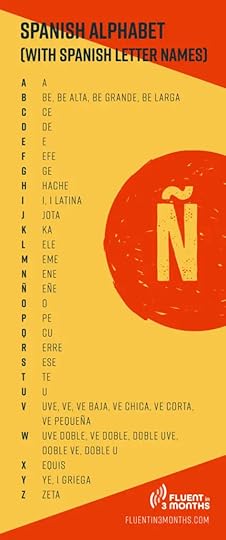
You may be surprised that some letters have multiple pronunciations. I’ll explain B and V later, but let me cover a couple others now:
W: In a lot of Latin American Spanish, speakers often call W doble ve, ve doble, or doble uve. However, some Central American countries, like Mexico, or Colombia have been influenced by the English name for W and call it doble u. On the other hand, Spaniards usually call it uve doble.Y: Y is very often called i griega (“Greek I”)- – this also distinguishes it from I, sometimes called i latina (“Latin I”). But the simplified ye name for Y is becoming incredibly standardized in Latin America.To help you learn, you can listen to the Spanish alphabet song. The popular children’s TV show Sesame Street actually made a version of this. Check it out:
You’ll notice a lot of similarities and also a lot of differences with the English alphabet. Let me explain some of the most important aspects to pay attention to.
Spanish VowelsUnlike English or French, Spanish vowels have only one possible pronunciation. It also corresponds with the IPA, or International Phonetic Alphabet.
A is pronounced /a/, like in “all.” An example is manzana (“apple”).E is pronounced /e/, like in “end.” An example is elefante (“elephant”).I is pronounced /i/, like the “ea” in “eat.” When Y is a vowel, it is pronounced the same as I. Examples are isla (“island”) and soy (“I am”).O is pronounced /o/, like in “orange.”An example is hola (“hello”).U is pronounced /u/, like the “ou” in “soup.” An example is usar (“use”). The only exceptions are when U comes after G or Q or is followed by an E or I, like in guerra (“war”) or queso (“cheese”). In these cases, the U it is silent. However, it is pronounced if it has an umlaut, or two dots, over it, like in vergüenza (“embarrassment”). This umlaut is called diéresis in Spanish. But don’t worry, there are relatively few words like this!Easy, right?
 Spanish Consonants
Spanish ConsonantsThere is more to explain about Spanish consonants – probably because there are many more of them. But don’t worry, they’re not too hard either.
Luckily, there are many consonants and consonant combinations in Spanish that are pronounced very closely to English. These include B, C, Ch, D, F, G, K, L, M, N, P, S, T, W, X, and Y. I will explain these shortly! Just note that most Spanish consonants are voiceless. That means you pronounce them without a puff of air, and your tongue often touches the top of your teeth.
In fact, W and K are rarely used in Spanish. They are mostly for foreign loanwords like karate and kiwi. That means you don’t really need to think about them at all!
Now let me explain some differences between English and Spanish pronunciations for some of these consonants.
How to Pronounce Spanish CThe letter C has some of the most variations in pronunciation. In most cases, it is pronounced the same as a hard C or K sound like in English. An example is carro (“car”).
However, when it is before an E or an I, it changes. The pronunciation depends on which dialect of Spanish the speaker uses.
If the speaker is from Central and Northern Spain, it’s pronounced like a voiceless “t” in English (like “thing”). But if the speaker is from most other regions, especially Latin America, it will be pronounced like an S. So the word ciudad (“city”) might be pronounced like “thiudad” or “siudad,” depending on the accent!
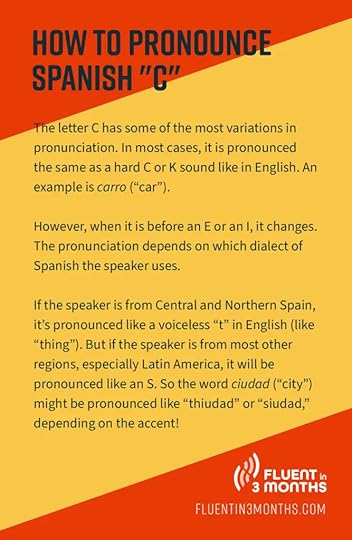 How to Pronounce Spanish G
How to Pronounce Spanish GUsually, G is pronounced like a hard English G, like in gate. An example is gato (“cat”). But similar to C above, if an E or I comes after G, it softens to an H sound, like in “house.” So general (“general”) is spelled exactly as in English, but is actually pronounced like “heneral”!
Also, remember how the letter U might change if it’s sandwiched between a G and either E or I? Well, this affects G’s pronunciation also! In these cases, the hard G sound remains, like in guerra (“war”) noted above.
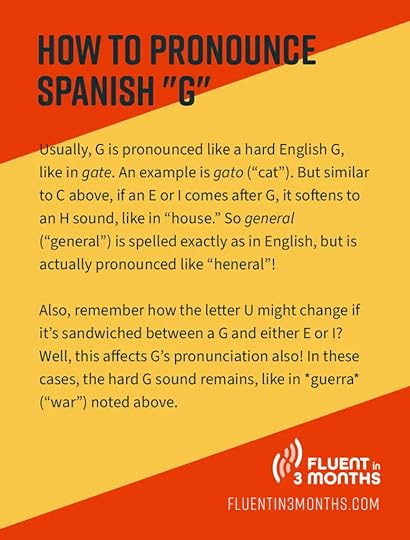 How to Pronounce Spanish H
How to Pronounce Spanish HHow do you pronounce H in Spanish? Well, unless it’s combined with other consonants, like Ch, you don’t! That’s why when you say hola (“hello”) in Spanish, you say it like “ola”!
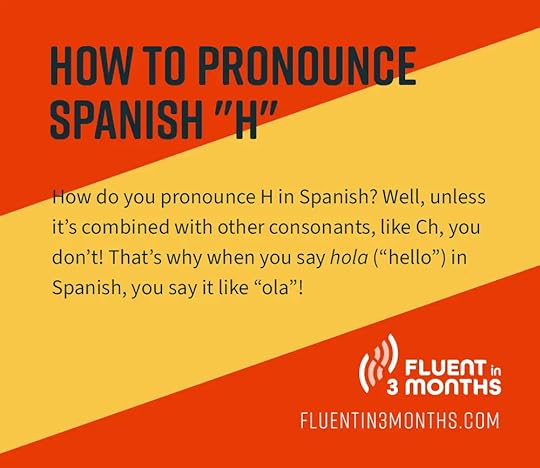 How to Pronounce J in Spanish
How to Pronounce J in SpanishIn most dialects of Spanish, the J is pronounced like an H (as in “house”) in English. So the word jugar (play) is pronounced like “hugar”.
But in most parts of Spain, it is often pronounced stronger and more from the throat. It actually reminds me a bit of some J sounds you would hear in Arabic and is perhaps influenced by it, being right across the Strait of Gibraltar!
 How to Pronounce Spanish Ll and Consonant Y
How to Pronounce Spanish Ll and Consonant YLl is a consonant cluster that has its own pronunciation in Spanish. None of them sound like the letter L, though. Again, how you pronounce it depends on what dialect of Spanish you’re speaking!
In most of the Spanish-speaking world (think Spain and most of Central and South America), it’s pronounced like a hard Y sound, like in “yogurt.” So lluvia (“rain”) is most often pronounced like “yuvia.” That’s also why ya (“already”) is pronounced similar to the English sound. This is what most students learn first and encounter the most.
On the other hand, in regions of some Spanish-speaking countries, Ll and Y might alternatively be pronounced like a soft J sound in English or like the soft “sh” sound in “treasure.” However, this is not standard in any one country.
Actually, the most famous pronunciation change belongs to Spanish as spoken in parts of Argentina and Uruguay. There, Ll and Y are pronounced like Sh in English. So lluvia (“rain”) sounds like “shuvia”, and ya (“already”) sounds like “sha”!
How to Pronounce Spanish ÑYou may have noticed that Ñ is the additional letter in the Spanish alphabet that does not belong to English. The squiggly line on the top is called a tilde, and the name was brought into English from Spanish.
The tilde may look intimidating, but don’t worry. It’s actually very simple to pronounce! It’s basically like a “ny” sound, like in “onion” or “lanyard.” Actually, have you ever drunk a piña colada? Now you know that it is written with the tilde in Spanish, and that’s why it has an “ny” sound!
 How to Pronounce Spanish Q
How to Pronounce Spanish QQ is a very simple sound in Spanish. It is always pronounced like a hard K sound and can only come before a U + E or U + I. So you’ll find words like queso (“cheese”) and quiero (“I want”), but never qeso or qero!
 How to Pronounce Spanish R
How to Pronounce Spanish RR is probably the letter most English speakers have difficulty with. This is because the R is always rolled in Spanish, and Spanish has specific rules for how much it is rolled.
When a single R comes in the middle or the end of a word, it is usually rolled once. (Some people say it is “flapped” instead.) Examples of this include letra (“letter”) and quiero (“I want”). Some people compare it to something in between an L and an R, or like the “dd” in English “ladder.”
R becomes more tricky when it comes at the beginning of a word or as a set of two Rs (called erre doble). Here, it is rolled or “trilled” longer than the examples above. Examples of this are correr (“to run”) and rumba (“rumba”). This also often happens when R follows an L, N, S, or Z, like the first R in alrededor (“surrounding”).
Don’t worry – it took me about a year of learning Spanish to finally be able to roll my R’s! Sometimes it’s just a matter of time and practice. We also have an article all about how to roll your R’s for extra help!
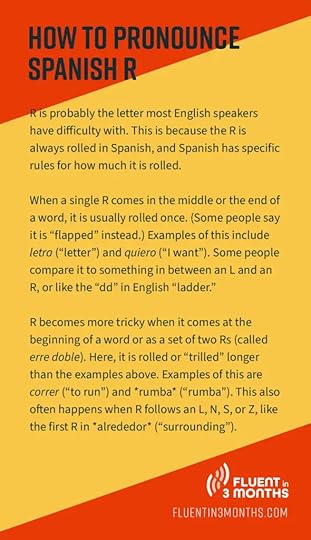 How to Pronounce Spanish X
How to Pronounce Spanish XDespite being quite uncommon in Spanish, X has a lot of possible pronunciations. This is often due to influence from other languages. Before a consonant or between vowels, it’s usually pronounced like a “ks” sound as it is in English. Examples are taxi (“taxi”) and extremo (“extreme”). However, when it starts a word, like in xenofobia (“xenophobia”), it is pronounced like an S.
But in some words derived from indigenous languages of the Americas, it takes on a different pronunciation. In words coming from Nahuatl, it’s pronounced like a strong H sound. That’s why the Spanish pronunciations for places like México and Oaxaca are pronounced with H sounds, not English “ks” sounds! In words from other languages, like the name Xiomara, it’s pronounced like an S or Sh sound.
 How to Pronounce Spanish V
How to Pronounce Spanish VThe pronunciation of V depends on where it is located in a word. At the beginning of a word or after an M or N, it’s pronounced like a B sound. So vamos (“we go”) sounds like “bamos.”
I’m sure you noticed in the alphabet above that B is called be and V is called ve, but the former might be called be alta/grande/larga (“tall/big/long B”), and the latter might be called ve baja/chica/pequeña/corta (“short/small V”). This is because since they both start the sound, they sound practically identical, and the adjective can help distinguish between the letters. The adjective used to distinguish B and V, if needed, usually differs from country to country, but Spanish speakers everywhere will usually understand you, whichever you choose.
However, when a V comes in the middle of a word, it’s pronounced like a mix between a V and a B. So the word vivir (“to live”) has two types of V sounds in it!
How to Pronounce Spanish ZZ in Spanish is usually pronounced the same as the C in ce or ci sounds as explained above. So in most of Spain, it’ll sound like a Th, but in Latin America, it’ll sound like an S. An example is paz (“peace”).
How to Use the Spanish Accent MarkYou may notice that Spanish uses an acute accent mark (´). Its use is simple: Whenever you see a letter with an accent mark, that’s where the stress is! That’s why águila (“eagle”) is pronounced like “Aguila” rather than “aGUIla,” and jamón (“ham”) is pronounced like “jamON” rather than “JAmon.”
This accent mark can be very important, differentiating words like tú (“you”) from tu (“your”) and sí (“yes”) from si (“if”). Add some extra emphasis to words with the accent marks.
You can also check out our complete guide to Spanish accent marks covering the acute accent mark and rules for stress, the tilde, and the diéresis for more information!
How to Keep Learning SpanishSo now that you’ve learned how to pronounce Spanish letters, what should you do next? Try building your vocabulary and learn some Spanish grammar. With the alphabet mastered, you’ll be reading, writing, speaking, and listening well in no time. Good luck!
Case Study: Learn Spanish in 11 WeeksHow to Learn the Korean Alphabet and Write in Korean [Step-by-Step Guide]The Language Learning Curve: What’s the Best Way for You to Improve Your Language Skills?How to Learn the Japanese Alphabet (With Charts!)A Guide to the Italian Alphabet and Italian Pronunciation (With Audio!)The post Master the Spanish Alphabet (With In-Depth Pronunciation Guide) appeared first on Fluent in 3 Months.



